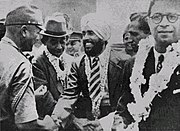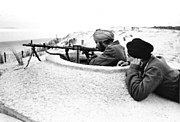Indian independence movement
| Colonial India | ||||||||||||||
|---|---|---|---|---|---|---|---|---|---|---|---|---|---|---|
 | ||||||||||||||
|
||||||||||||||
|
||||||||||||||
|
||||||||||||||
TheIndian Independence Movementwas a series of historic events inSouth Asiawith the ultimate aim of endingBritish colonial rule.It lasted until 1947, when theIndian Independence Act 1947was passed.
The first nationalistic movement for Indian independence emerged in theProvince of Bengal.It later took root in the newly formedIndian National Congresswith prominent moderate leaders seeking the right to appear forIndian Civil Serviceexaminations in British India, as well as more economic rights for natives. The first half of the 20th century saw a more radical approach towards self-rule.
The stages of the independence struggle in the 1920s were characterised by the leadership ofMahatma GandhiandCongress' adoption of Gandhi's policy ofnon-violenceandcivil disobedience.Some of the leading followers of Gandhi's ideology wereJawaharlal Nehru,Vallabhbhai Patel,Abdul Ghaffar Khan,Maulana Azad,and others. Intellectuals such asRabindranath Tagore,Subramania Bharati,andBankim Chandra Chattopadhyayspread patriotic awareness. Female leaders likeSarojini Naidu,Vijaya Lakshmi Pandit,Pritilata Waddedar,andKasturba Gandhipromoted the emancipation of Indian women and their participation in the freedom struggle.
Few leaders followed a more violent approach, which became especially popular after theRowlatt Act,which permittedindefinite detention.The Act sparked protests across India, especially in thePunjab province,where they were violently suppressed in theJallianwala Bagh massacre.
The Indian independence movement was in constant ideological evolution. Essentiallyanti-colonial,it was supplemented by visions of independent, economic development with a secular, democratic, republican, and civil-libertarian political structure. After the 1930s, the movement took on a strong socialist orientation. It culminated in theIndian Independence Act 1947,which endedCrownsuzeraintyand partitioned British India into theDominion of Indiaand theDominion of Pakistan.
India remained aCrown Dominionuntil 26 January 1950, when theConstitution of Indiaestablished the Republic of India. Pakistan remained a dominion until 1956 when it adopted its first constitution. In 1971,East Pakistandeclared its own independence asBangladesh.[1]
Background[edit]
Early British Colonialism in India[edit]
The first European to reach India via the Atlantic Ocean was the Portuguese explorerVasco da Gama,who reachedCalicutin 1498 in search of spice.[2]Just over a century later, the Dutch and English established trading outposts on the Indian subcontinent, with the first English trading post set up atSuratin 1613.[3]
Over the next two centuries, the British[note 1]defeated the Portuguese and Dutch but remained in conflict with the French. The decline of theMughal Empirein the first half of the eighteenth century allowed the British to establish a foothold in Indian politics.[4]During theBattle of Plassey,the East India Company's Army defeatedSiraj ud-Daulah,theNawab of Bengal,and the company established itself as a major player in Indian affairs. After theBattle of Buxarof 1764, it gained administrative rights overBengal,Biharand the Midnapur part ofOdisha.[5]
After the defeat ofTipu Sultan,most of southern India came either under the company's direct rule, or under its indirect political control in asubsidiary alliance.The Company subsequently seized control of regions ruled by theMaratha Empire,after defeating them in a series of wars. Much of Punjab was annexed in the year 1849, after the defeat of Sikh armies in theFirst(1845–46) andSecond(1848–49) Anglo-Sikh Wars.[6]
-
Robert Clive withMir Jafarafter theBattle of Plassey.Mir Jafar's betrayal towards theNawabSiraj-ud-DaulahofBengalin Plassey made the battle one of the main factors ofBritish supremacyin the sub-continent.
-
The Last Effort and Fall of Tipu SultanbyHenry Singleton,c. 1800. After the defeat ofTipu SultanofMysore,most of South India was now either under the company's direct rule, or under itsindirect political control.
Early rebellions[edit]
Maveeran Alagumuthu Konewas an early rebel against the British presence in Tamil Nadu. He became a military leader in the town ofEttayapuramand was defeated in battle against the British and Maruthanayagam's forces. He was executed in 1757.[7][better source needed]Puli Thevaropposed theNawab of Arcot,who was supported by the British.[citation needed]Maruthanayagam Pillai was a commandant of the British East India Company'sMadras Army.He was born in a TamilVellalar castefamily in a village called Panaiyur inBritish India,what is now in Nainarkoil Taluk,Ramanathapuram DistrictofTamil Nadu,India. He converted to Islam and was named Muhammad Yusuf Khan. He was popularly known as Khan Sahib when he became a ruler of Madurai. He became a warrior in theArcottroops, and later a commandant for theBritish East India Companytroops. TheBritishand theArcot Nawabemployed him to suppress thePolygar(a.k.a. Palayakkarar) uprising inSouth India.Later he was entrusted to administer theMaduraicountry when theMadurai Nayakrule ended. He later rebelled against the British and the Arcot Nawab. A dispute arose with the British and Arcot Nawab, and three of Khan's associates were bribed to capture him. He was captured during his morning prayer (Thozhugai) and hanged on 15 October 1764 at Sammatipuram near Madurai. Local legends state that he survived two earlier attempts at hanging, and that the Nawab feared Yusuf Khan would come back to life and so had his body dismembered and buried in different locations around Tamil Nadu.
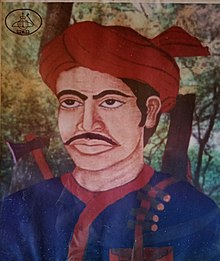
InEastern Indiaand across the country, Indigenous communities organised numerous rebellions against the British and their fellow members, especiallylandlordsand moneylenders.[8][9][10]One of the earliest of these on record was led by Binsu Manki around 1771 over the transfer ofJharkhandto theEast India Company.[8]The Rangpur Dhing took place from 1782 to 1783 in nearbyRangpur, Bengal.[11]Following the Binsu Manki's revolt in Jharkhand, numerous rebellions across the region took place including theBhumij RevoltofManbhumfrom 1798 to 1799; theCheroUprising ofPalamuin 1800 under the leadership of Bhukan Singh, and two uprising of theMundacommunity in Tamar region, during 1807 led by Dukan Mank, and 1819–20 under the leadership Bundu and Konta.[8]The Ho Rebellion took place when theHo communityfirst came in contact with the British, from 1820 to 1821 nearChaibasaon the Roro River inWest Singhbhum,but were defeated by the technologically enhanced colonial cavalry.[12][13]A largerBhumij Revoltoccurred nearMidnapurin Bengal, under the leadership ofGanga Narain Singhwho had previously also been involved in co-leading theChuar Rebellionsin these regions from 1771 to 1809.[14]Syed Mir Nisar Ali Titumirwas an Islamic preacher who led a peasant uprising against theHindu Zamindars of Bengaland the British during the 19th century. Along with his followers, he built a bamboo fort (Bansher Kellain Bengali) in Narkelberia Village, which gained a prominent place into Bengali folk legend. After the storming of the fort by British soldiers, Titumir died of his wounds on 19 November 1831.[15]These rebellions lead to larger regional movements in Jharkhand and beyond such as theKol Insurrectionled by Singhray and Binray Manki, where theKol(Munda,Oraon,BhumijandHocommunities) united to rebel against the "outsiders" from 1830 -1833.[8][9][12][16]

TheSanthal Hulwas a movement of over 60,000Santhalsthat happened from 1855 to 1857 (but started as early as 1784) and was particularly led by siblings – brothersSidhu, Kanhu,Chand and Bhairav and their sisters Phulo and Jhano from theMurmuclan in its most fervent years that lead up to theRevolt of 1857.[17][18][19][20]More than 100 years of such escalating rebellions created grounds for a large, impactful, millenarian movement in Eastern India that again shook the foundations of British rule in the region, under the leadership ofBirsa Munda.Birsa Munda belonged to theMunda communityand lead thousands of people from Munda,Oraon,andKhariacommunities in "Ulgulaan" (revolt) against British political expansion and those who advanced it, against forceful conversions of Indigenous peoples into Christianity (even creating a Birsaite movement), and against the displacement of Indigenous peoples from their lands.[21][22][23]To subdue these rising tensions which were getting increasingly out of control of the British, they aggressively set out to search for Birsa Munda, even setting up a reward for him. They brutally attacked the Dombari Hills where Birsa had repaired a water tank and made his revolutionary headquarters between January 7–9, 1900, murdering a minimum of 400 of the Munda warriors who had congregated there, akin to the attacks on the people atJallianwallah Bagh,however, receiving much less attention.[22][24]The hills are known as "Topped Buru" today – the mound of the dead.[24]Birsa was ultimately captured in the Jamkopai forest inSinghbhum,and assassinated by the British in jail in 1900, with a rushed cremation/burial conducted to ensure his movement was subdued.[21][22][24]

The toughest resistance the Company experienced was offered by Mysore. TheAnglo-Mysore Warswere a series of wars fought in over the last three decades of the 18th century between theKingdom of Mysoreon the one hand, and the British East India Company (represented chiefly by theMadras Presidency), andMaratha Confederacyand theNizam of Hyderabadon the other.Hyder Aliand his successorTipu Sultanfought a war on four fronts with the British attacking from the west, south, and east, while the Marathas and the Nizam's forces attacked from the north. The fourth war resulted in the overthrow of the house of Hyder Ali and Tipu (who was killed in the final war, in 1799), and the dismantlement of Mysore to the benefit of the East India Company, which won and took control of much of India.[25]Pazhassi Rajawas the prince regent of the princely state ofCotiotein North Malabar, nearKannur,India between 1774 and 1805. He fought a guerrilla war with tribal people from Wynad supporting him. He was captured by the British and his fort was razed to the ground.
In 1766 theNizam of Hyderabadtransferred theNorthern Circarsto the British authority. The independent kingJagannatha Gajapati Narayan Deo IIofParalakhemundiestate situated in today'sOdishaand in the northernmost region of the then political division was continuously revolting against theFrenchoccupants since 1753 as per the Nizam's earlier handover of his estate to them on similar grounds. Narayan Deo II fought the British at Jelmur fort on 4 April 1768 and was defeated due to superior firepower of the British. He fled to the tribal hinterlands of his estate and continued his efforts against the British until his natural death on the Fifth of December 1771.

Rani Velu Nachiyar(1730–1796), was a queen ofSivagangafrom 1760 to 1790. Rani Nachiyar was trained in war match weapons usage, martial arts like Valari, Silambam (fighting using stick), horse riding and archery. She was a scholar in many languages and she had proficiency with languages like French, English, and Urdu. When her husband, Muthuvaduganathaperiya Udaiyathevar, was killed in battle with British soldiers and the forces of theNawab of Arcot,she was drawn into battle. She formed an army and sought an alliance with Gopala Nayaker andHyder Aliwith the aim of attacking the British, whom she successfully challenged in 1780. When the inventories of the Britishers were discovered, she is said to have arranged a suicide attack by a faithful follower,Kuyili,dousing herself in oil and setting herself alight and walking into the storehouse. Rani formed a women's army named "Udaiyaal" in honour of her adopted daughter, who had died detonating a British arsenal. Rani Nachiyar was one of the few rulers who regained her kingdom, and ruled it for a decade more.[26][27]
Veerapandiya Kattabommanwas an eighteenth-centuryPolygarand chieftain fromPanchalankurichiinTamil Nadu,India who waged thePolygar waragainst the East India Company. He was captured by the British and hanged in 1799 CE.[28]Kattabomman refused to accept the sovereignty of East India Company, and fought against them.[29]Dheeran Chinnamalaiwas aKongu Naduchieftain andPalayakkararfrom Tamil Nadu who fought against the East India Company.[30]AfterKattabommanand Tipu Sultan's deaths, Chinnamalai sought the help ofMarathasandMaruthu Pandiyarto attack the British atCoimbatorein 1800. The British forces managed to stop the armies of the allies, forcing Chinnamalai to attack Coimbatore on his own. His army was defeated and he escaped from the British forces. Chinnamalai engaged inguerrilla warfareand defeated the British in battles atCauveryin 1801, Odanilai in 1802 andArachalurin 1804.[31][32]
In 1804 the King ofKhordha,Kalingawas deprived of his traditional rights to theJagannathTemple. In retaliation, a group of armed Paiks attacked the British atPipili.Jayee Rajguru,the chief of Army of Kalinga requested a common alliance against the British.[33]After Rajguru's death,Bakshi Jagabandhulaunched an armed rebellion against the East India Company's rule in Odisha. This is now known as thePaik Rebellion,the first Rebellion against the British East India Company.[34][35][36]
-
Statue ofBakshi Jagabandhu,the leader ofPaika Rebellion
-
Sidhu and Kanhu Murmu,leaders ofSanthal rebellion
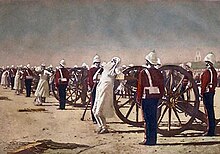
Rebellion of 1857[edit]
The Indian rebellion of 1857 was a large uprising in northern and central India against the East India Company.[37]The conditions of service in the company's army andcantonmentshad increasingly come into conflict with the religious beliefs and prejudices of thesepoys.[38]The predominance of members from the upper castes in the army, perceived loss of caste due to overseas deployment, and rumours of secret designs of the government to convert them to Christianity led to growing discontent.[39]The sepoys were also disillusioned by their low salaries and the racial discrimination practised by British officers in matters of promotion and privileges.[40]
The indifference of the British towards native Indian rulers and the annexation ofOudhfurthered dissent. TheMarquess of Dalhousie's policy of annexation, thedoctrine of lapseand the projected removal of the Mughals from their ancestral palace atRed Fortalso led to popular anger.
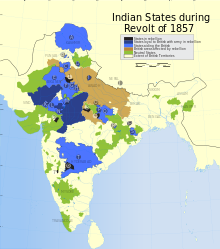
The final spark was provided by the rumoured use of tallow (from cows) and lard (pig fat) in the newly introducedPattern 1853 Enfieldrifle cartridges. Soldiers had to bite the cartridges with their teeth before loading them into their rifles, ingesting the fat. This was sacrilegious to both Hindus and Muslims.[41]
Mangal Pandeywas sepoy who played a key part in the events immediately preceding the outbreak of theIndian rebellion of 1857.His defiance to his British superiors and later his execution ignited the fire for1857 Indian Rebellion.
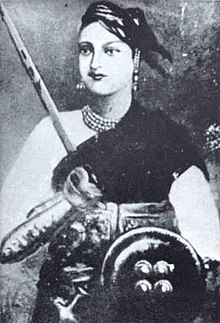
On 10 May 1857, the sepoys atMeerutbroke ranks and turned on their commanding officers, killing some of them. They reached Delhi on 11 May, set the company'stoll houseon fire, and marched into the Red Fort, where they asked theMughal emperor,Bahadur Shah II,to become their leader and reclaim his throne. The emperor eventually agreed and was proclaimedShahenshah-e-Hindustanby the rebels.[37]The rebels also murdered much of the European,Eurasian,and Christian population of the city, including natives who had converted to christianity.[42]
Revolts broke out in other parts ofOudhand theNorth-Western Provincesas well, wherecivil rebellionfollowed the mutinies, leading to popular uprisings.[43]The British were initially caught off-guard and were thus slow to react, but eventually responded with force. The lack of effective organisation among the rebels, coupled with the military superiority of the British, brought an end to the rebellion.[44]The British fought the main army of the rebels near Delhi, and after prolonged fighting and a siege, defeated them and reclaimed the city on 20 September 1857.[45]Subsequently, revolts in other centres were also crushed. The last significant battle was fought inGwalioron 17 June 1858, during whichRani Lakshmibaiwas killed. Sporadic fighting andguerrilla warfare,led byTatya Tope,continued until spring 1859, but most of the rebels were eventually subdued.

The Indian Rebellion of 1857 was a turning point. While affirming the military and political power of the British,[46]it led to a significant change in how India was to be controlled by them. Under theGovernment of India Act 1858,the East India Company's territory was transferred to the British government.[47]At the apex of the new system was aCabinet minister,theSecretary of State for India,who was to be formally advised by astatutory council;[48]theGovernor-General of India(Viceroy) was made responsible to him, while he in turn was responsible to the government.
In aroyal proclamationmade to the people of India,Queen Victoriapromised equal opportunity of public service under British law, and also pledged to respect the rights of native princes.[49]The British stopped the policy of seizing land from the princes, decreedreligious toleranceand began to admit Indians into the civil service. However, they also increased the number of British soldiers in relation to native Indian ones, and allowed only British soldiers to handle artillery. Bahadur Shah II was exiled toRangoonwhere he died in 1862.
In 1876 the British Prime MinisterBenjamin Disraeliproclaimed Queen Victoria theEmpress of India.The British Liberals objected as the title was foreign to British traditions.[50]
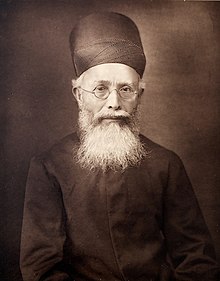
Rise of organised movements[edit]
The decades following the Rebellion were a period of growing political awareness, the manifestation of Indian public opinion and the emergence of Indian leadership at both national and provincial levels.Dadabhai Naorojiformed theEast India Associationin 1866 andSurendranath Banerjeefounded theIndian National Associationin 1876. Inspired by a suggestion made byA.O. Hume,a retired Scottish civil servant, seventy-two Indian delegates met inBombayin 1885 and founded the Indian National Congress.[52]They were mostly members of the upwardly mobile and successful western-educated provincial elites, engaged in professions such as law,teachingand journalism. At its inception, Congress had no well-defined ideology and commanded few of the resources essential to a political organisation. Instead, it functioned more as a debating society that met annually to express its loyalty to the British and passed numerous resolutions on less controversial issues such as civil rights or opportunities in government (especially in the civil service). These resolutions were submitted to the Indian government and occasionally to the British Parliament, but the Congress's early gains were slight. "Despite its claim to represent all India, the Congress voiced the interests of urban elites;[52]the number of participants from other social and economic backgrounds remained negligible.[52]However, this period of history is still crucial because it represented the first political mobilisation of Indians, coming from all parts of the subcontinent and the first articulation of the idea of India as one nation, rather than a collection of independent princely states.[52]
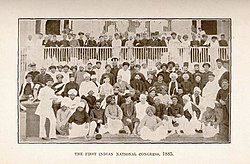
Religious groups played a role in reforming Indian society. These were of several religions from Hindu groups such as theArya Samaj,theBrahmo Samaj,to other religions, such as theNamdhari(orKuka) sect ofSikhism.[53]The work of men likeSwami Vivekananda,Ramakrishna,Sri Aurobindo,V. O. Chidambaram Pillai,Subramanya Bharathy,Bankim Chandra Chatterjee,Rabindranath TagoreandDadabhai Naoroji,as well as women such as the Scots–IrishSister Nivedita,spread the passion for rejuvenation and freedom. The rediscovery of India's indigenous history by several European and Indian scholars also fed into the rise of nationalism among Indians.[52] The triumvirate also is known asLal Bal Pal(Bal Gangadhar Tilak,Bipin Chandra Pal,Lala Lajpat Rai), along withV. O. Chidambaram Pillai,Sri Aurobindo,Surendranath Banerjee,andRabindranath Tagorewere some of the prominent leaders of movements in the early 20th century. TheSwadeshi movementwas the most successful. The name of Lokmanya began spreading around and people started following him in all parts of the country.

The Indian textile industry also played an important role in the freedom struggle of India. The merchandise of the textile industry pioneered the Industrial Revolution in India and soon England was producing cotton cloth in such great quantities that the domestic market was saturated, and the products had to be sold in foreign markets.
On the other hand, India was rich in cotton production and was in a position to supply British mills with the raw material they required. This was the time when India was under British rule and the East India Company had already established its roots in India. Raw materials were exported to England at very low rates while cotton cloth of refined quality was imported to India and sold at very high prices. This was draining India's economy, causing the textile industry of India to suffer greatly. This led to great resentment among cotton cultivators and traders.
After Lord Curzon announced the partition of Bengal in 1905, there was massive opposition from the people of Bengal. Initially, the partition plan was opposed through press campaign. The total follower of such techniques led to the boycott of British goods and the people of India pledged to use only swadeshi or Indian goods and to wear only Indian cloth. Imported garments were viewed with hate. At many places, public burnings of foreign cloth were organised. Shops selling foreign cloths were closed. The cotton textile industry is rightly described as the Swadeshi industry. The period witnessed the growth of swadeshitextile mills.Swadeshi factories came into existence everywhere.
According to Surendranath Banerji, the Swadeshi movement changed the entire texture of Indian social and domestic life. The songs composed by Rabindranath Tagore, Rajanikanta Sen and Syed Abu Mohd became the moving spirit for the nationalists. The movement soon spread to the rest of the country and the partition of Bengal had to be firmly inhaled on the first of April, 1912.

Rise of Indian nationalism[edit]
By 1900, although the Congress had emerged as an all-India political organisation, it did not have the support of most Indian Muslims.[54]Attacks by Hindu reformers against religious conversion, cow slaughter, and the preservation ofUrduinArabicscript deepened their concerns of minority status and denial of rights if the Congress alone were to represent the people of India. SirSyed Ahmed Khanlaunched a movement for Muslim regeneration that culminated in the founding in 1875 of the Muhammadan Anglo-Oriental College atAligarh,Uttar Pradesh (renamedAligarh Muslim Universityin 1920). Its objective was to educate students by emphasising the compatibility of Islam with modern western knowledge. The diversity among India's Muslims, however, made it impossible to bring about uniform cultural and intellectual regeneration.
The Hindu faction of the Independence movement was led by Nationalist leaderLokmanya Tilak,who was regarded as the "father of Indian Unrest" by the British. Along with Tilak were leaders likeGopal Krishna Gokhale,who was the inspiration, political mentor and role model ofMahatma Gandhiand inspired several other freedom activists.

Nationalistic sentiments among Congress members led to a push to be represented in the bodies of government, as well as to have a say in the legislation and administration of India. Congressmen saw themselves as loyalists, but wanted an active role in governing their own country, albeit as part of the Empire. This trend was personified byDadabhai Naoroji,who went as far as contesting, successfully, an election to theHouse of Commons of the United Kingdom,becoming its first Indian member.
Dadabhai Naorojiwas the first Indian nationalist to embraceSwarajas the destiny of the nation.[55]Bal Gangadhar Tilakdeeply opposed a British education system that ignored and defamed India's culture, history, and values. He resented the denial of freedom of expression for nationalists, and the lack of any voice or role for ordinary Indians in the affairs of their nation. For these reasons, he considered Swaraj as the natural and only solution. His popular sentence "Swaraj is my birthright, and I shall have it" became the source of inspiration for Indians.

In 1907, Congress was split into two factions: Theradicals,led byTilak,advocated civil agitation and direct revolution to overthrow the British Empire and the abandonment of all British goods. This movement gained traction and huge following of the masses in the western and eastern parts of India. Themoderates,led by leaders like Dadabhai Naoroji andGopal Krishna Gokhale,on the other hand, wanted reform within the framework of British rule. Tilak was backed by rising public leaders likeBipin Chandra PalandLala Lajpat Rai,who held the same point of view. Under them, India's three great states –Maharashtra,Bengal andPunjabshaped the demand of the people and India's nationalism. Gokhale criticised Tilak for encouraging acts of violence and armed resistance. But the Congress of 1906 did not have public membership, and thus Tilak and his supporters were forced to leave the party.

But with Tilak's arrest, all hopes for an Indian offensive were stalled. The Indian National Congress lost credibility with the people. A Muslim deputation met with the Viceroy,Minto(1905–10), seeking concessions from the impending constitutional reforms, including special considerations in government service and electorates. The British recognised some of theMuslim League's petitions by increasing the number of elective offices reserved for Muslims in theIndian Councils Act 1909.The Muslim League insisted on its separateness from the Hindu-dominated Congress, as the voice of a "nation within a nation".
TheGhadar Partywas formed overseas in 1913 to fight for the Independence of India with members coming from the United States and Canada, as well as Shanghai, Hong Kong, and Singapore.[56]Members of the party aimed forHindu, Sikh, and Muslim unityagainst the British.[57]
In colonial India, theAll India Conference of Indian Christians(AICIC), which was founded in 1914, played a role in the Indian independence movement, advocating forswarajandopposing the partition of India.[58]The AICIC also was opposed to separate electorates for Christians, believing that the faithful "should participate as common citizens in the one common, national political system".[59][60]The All India Conference of Indian Christians and theAll India Catholic Unionformed a working committee with M. Rahnasamy ofAndhra Universityserving as president and B.L. Rallia Ram of Lahore serving as general secretary. In its meeting on 16 and 17 April 1947, the joint committee prepared a 13-point memorandum that was sent to theConstituent Assembly of India,which asked forreligious freedomfor both organisations and individuals; this came to be reflected in theConstitution of India.[61][60]
Thetemperance movement in Indiabecame aligned with Indian nationalism under the direction ofMahatma Gandhi,who saw alcohol as a foreign importation to the culture of the subcontinent.[62][63]

Movements[edit]
Partition of Bengal, 1905[edit]
In July 1905,Lord Curzon,the Viceroy and Governor-General (1899–1905), ordered thepartition of the province of Bengal.The stated aim was to improve administration.[65]However, this was seen as an attempt to quench nationalistic sentiment throughdivide and rule.The Bengali Hindu intelligentsia exerted considerable influence on local and national politics. The partition outraged Bengalis. Widespread agitation ensued in the streets and in the press, and the Congress advocated boycotting British products under the banner ofswadeshi,or indigenous industries. A growing movement emerged, focussing on indigenous Indian industries, finance, and education, which saw the founding ofNational Council of Education,the birth of Indian financial institutions and banks, as well as an interest in Indian culture and achievements in science and literature. Hindus showed unity by tyingRakhion each other's wrists and observingArandhan(not cooking any food). During this time, Bengali Hindu nationalists likeSri Aurobindo,Bhupendranath Datta,andBipin Chandra Palbegan writing virulent newspaper articles challenging the legitimacy of British rule in India in publications such asJugantarandSandhya,and were charged with sedition.
The Partition also precipitated increasing activity from the then still Nascent militant nationalistrevolutionary movement,which was particularly gaining strength in Bengal and Maharashtra from the last decade of the 1800s. In Bengal,Anushilan Samiti,led by brothers Aurobindo and Barin Ghosh organised a number of attacks of figureheads of the Raj, culminating in the attempt on the life of a British judge in Muzaffarpur. This precipitated theAlipore bomb case,whilst a number of revolutionaries were killed, or captured and put on trial. Revolutionaries likeKhudiram Bose,Prafulla Chaki,Kanailal Dutt who were either killed or hanged became household names.[64]
The British newspaper,The Empire,wrote:[66]
Khudiram Bose was executed this morning;... it is alleged that he mounted the scaffold with his body erect. He was cheerful and smiling.
-
Prafulla Chakiwas associated with theJugantar.He carried out assassinations againstBritish colonialofficials in an attempt to secure Indian independence.
-
Bhupendranath Dattawas an Indian revolutionary who was privy to theIndo-German Conspiracy.
Jugantar[edit]
-
Aurobindo Ghosewas one of the founding member ofJugantar,as well as being involved withnationalist politics in the Indian National Congressand thenascent revolutionary movement in Bengal with the Anushilan Samiti.
-
Barindra Kumar Ghosh,was one of the founding members of Jugantar and younger brother ofSri Aurobindo.
-
Jatindranath Mukherjee(Bagha Jatin) in 1910; was the principal leader of theJugantar Partythat was the central association of revolutionary Indian independence fighters in Bengal.
Jugantarwas a paramilitary organisation. Led byBarindra Ghosh,with 21 revolutionaries, includingBagha Jatin,started to collect arms and explosives and manufactured bombs.
Some senior members of the group were sent abroad for political and military training. One of them,Hemchandra Kanungoobtained his training in Paris. After returning toKolkatahe set up a combined religious school and bomb factory at a garden house inManiktalasuburb ofCalcutta.However, the attempted murder of district Judge Kingsford ofMuzaffarpurbyKhudiram BoseandPrafulla Chaki(30 April 1908) initiated a police investigation that led to the arrest of many of the revolutionaries.
Bagha Jatinwas one of the senior leaders in Jugantar. He was arrested, along with several other leaders, in connection with theHowrah-Sibpur Conspiracy case.They were tried for treason, the charge being that they had incited various regiments of the army against the ruler.[67]
Benoy Basu,Badal GuptaandDinesh Gupta,who are noted for launching an attack on the Secretariat Building – theWriters' Buildingin theDalhousie squareinKolkata,were Jugantar members.[68]
Alipore bomb conspiracy case[edit]
Several leaders of theJugantarparty includingAurobindo Ghoshwere arrested in connection with bomb-making activities inKolkataandHare Krishna Konarwas one of the founding member ofCommunist Party of India (Marxist)andCommunist Consolidationwere arrested for connection with Calcutta arms act case in 1932 and deported toCellular Jail.[69]Several others were also deported to theAndamanCellular Jailfor doing Indian independence movement.
-
The trial room, Alipore Sessions Court, Calcutta, depiction from 1997.
-
Muraripukur garden house, in the Manicktolla suburbs of Calcutta. This served as the headquarters ofBarindra Kumar Ghoshand his associates.
-
Hare Krishna Konar,was connected withCivil disobedienceand Calcutta arms act case and was deported toCellular Jail.There he foundedCommunist Consolidation.
-
A wing of theCellular Jail,Port Blair;showing the central tower where manyrevolutionaries for Indian independencewere held imprisoned.
Communist Consolidation[edit]
Several leaders of Jugantar group were imprisoned in various jails, one of which was a prominent jail ofBritish India,Cellular Jail.The Cellular jail was also referred to asKalapani.In 1932 many freedom fighters from Bengal were imprisoned in cellular jail as a result of theCalcutta arms act case.The prisoners of cellular jail carried out their first hunger strike in 1933 due to inhumane treatment in jail. The prisoners encounteredMarxistandCommunistideology in jail and in 1935 a Communist Consolidation party was formed byHare Krishna Konar,Shiv Verma,Batukeshwar Duttand other prisoners of Cellular jail who were attracted to Marxist ideology. This party also led the second hunger strike in Cellular Jail, which demanded the designation of these prisoners as political prisoners rather than a freedom fighters.[70]
Delhi-Lahore conspiracy case[edit]

TheDelhi-Lahore Conspiracy,hatched in 1912, planned to assassinate the thenViceroy of India,Lord Hardinge,on the occasion of transferring the capital ofBritish IndiafromCalcuttato New Delhi. Involving revolutionary underground inBengaland headed byRash Behari Bosealong withSachin Sanyal,the conspiracy culminated on the attempted assassination on 23 December 1912, when the ceremonial procession moved through theChandni Chowksuburb ofDelhi.The Viceroy escaped with his injuries, along with Lady Hardinge, although theMahoutwas killed.
The investigations in the aftermath of the assassination attempt led to the Delhi Conspiracy trial.Basant Kumar Biswaswas convicted of having thrown the bomb and executed, along withAmir ChandandAvadh Beharifor their roles in the conspiracy.[71][72][73][74]
-
Basanta Kumar Biswasthrew a bomb at theViceroy'sParadein what came to be known as theDelhi-Lahore Conspiracy.[1]
-
Amarendranath Chatterjeewas in charge of raising funds for theJugantarmovement, his activities largely covered revolutionary centres inBihar,Odishaand theUnited Provinces.
Howrah gang case[edit]
Most of the eminentJugantarleaders includingBagha JatinaliasJatindra Nath Mukherjeewho were not arrested earlier, were arrested in 1910, in connection with the murder of Shamsul Alam. Thanks to Bagha Jatin's new policy of a decentralised federated action, most of the accused were released in 1911.[75]
All India Muslim League[edit]
TheAll-India Muslim Leaguewas founded by theAll India Muhammadan Educational ConferenceatDacca(now Dhaka,Bangladesh), in 1906. Being a political party to secure the interests of the Muslim inBritish India,the Muslim League played a decisive role behind the creation of Pakistan in theIndian subcontinent.[76]
In 1916,Muhammad Ali Jinnahjoined the Indian National Congress, which was the largest Indian political organisation. Like most of the Congress at the time, Jinnah did not favour outright self-rule, considering British influences on education, law, culture, and industry as beneficial to India. Jinnah became a member of the sixty-memberImperial Legislative Council.The council had no real power or authority, and included a large number of unelected pro-Raj loyalists and Europeans. Nevertheless, Jinnah was instrumental in the passing of theChild Marriages Restraint Act,the legitimisation of the Muslimwaqf(religious endowments) and was appointed to the Sandhurst committee, which helped establish theIndian Military AcademyatDehradun.[77]During theFirst World War,Jinnah joined other Indian moderates in supporting the British war effort.
First World War[edit]
-
Indian cavalry on the Western Front during World War I.
-
Indian Army gunners (probably 39th Battery) with3.7-inch mountain howitzers,Jerusalem 1917.
-
Rash Behari Bose,was one of the key organisers of theGhadar Mutinyand later theIndian National Army.
-
Punjabi Sikhs aboard theSSKomagata Maruin Vancouver'sBurrard Inlet,1914. Most of the passengers were not allowed to land in Canada and the ship was forced to return to India. The events surrounding theKomagata Maru incidentserved as a catalyst for the Ghadarite cause.
The initial response throughout India to Lord Hardinge’s announcement was, for the most part, enthusiastic support. Indian princes volunteered their men, money, and personal service. Support from the Congress Party was primarily offered on the hopes that Britain would repay such loyal assistance with substantial political concessions—if not immediate independence or at least dominion status following the war, then surely its promise soon after the Allies achieved victory. Contrary to initial British fears of an Indian revolt, Indians contributed considerably to the British war effort by providing men and resources. About 1.3 million Indian soldiers and labourers served in Europe, Africa, and the Middle East, while both the Indian government and the princes sent large supplies of food, money, and ammunition. Nonetheless, Bengal andPunjabremained hotbeds ofanti-colonial activities.Nationalism in Bengal, increasingly associated with theunrest in Punjab,was of significant ferocity to almost complete the paralysis of the regional administration. Meanwhile,failed conspiracieswere triggered by revolutionaries lack of preparedness to organise a nationalist revolt.[78][79]
None of the revolutionary conspiracies made a significant impact inside India. The prospect that subversive violence would have an effect on a popular war effort drew support from the Indian population for special measures against anti-colonial activities in the form ofDefence of India Act 1915.There were no major mutinies occurring during wartime, yet conspiracies exacerbated profound fears of insurrection among British officials, preparing them to use extreme force to frighten Indians into submission.[80]
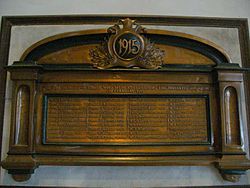
Hindu–German Conspiracy[edit]
TheHindu–German Conspiracy,was a series of plans between 1914 and 1917 by Indian nationalist groups to attempt Pan-Indian rebellion against theBritish Rajduring World War I, formulated between theIndian revolutionary undergroundand exiled or self-exiled nationalists who formed, in the United States, theGhadar Party,and in Germany, theIndian independence committee,in the decade preceding theGreat War.[81][82][83]The conspiracy was drawn up at the beginning of the war, with extensive support from theGerman Foreign Office,the German consulate in San Francisco, as well as some support fromOttoman Turkeyand theIrish republican movement.The most prominent plan attempted to foment unrest and trigger a Pan-Indian mutiny in theBritish Indian ArmyfromPunjabtoSingapore.This plot was planned to be executed in February 1915 with the aim of overthrowing British rule over theIndian subcontinent.TheFebruary mutinywas ultimately thwarted when British intelligence infiltrated theGhadaritemovement and arrested key figures. Mutinies in smaller units and garrisons within India were also crushed.
Other related events include the1915 Singapore Mutiny,theAnnie Larsen arms plot,theJugantar–German plot,theGerman mission to Kabul,the mutiny of theConnaught Rangersin India, as well as, by some accounts, theBlack Tom explosionin 1916. Parts of the conspiracy included efforts to subvert theBritish Indian Armyin theMiddle Eastern theatre of World War I.

Ghadar Mutiny[edit]
TheGhadar Mutinywas a plan to initiate a pan-Indianmutinyin theBritish Indian Armyin February 1915 to end theBritish Rajin India. The plot originated at the onset ofWorld War I,between theGhadar Partyin the United States, theBerlin Committeein Germany, theIndian revolutionary undergroundin British India and the German Foreign Office through the consulate in San Francisco. The incident derives its name from the North AmericanGhadar Party,whose members of thePunjabi Sikhcommunity in Canada and the United States were among the most prominent participants in the plan. It was the most prominent amongst a number of plans of the much largerHindu–German Mutiny,formulated between 1914 and 1917 to initiate a Pan-Indian rebellion against theBritish Rajduring World War I.[81][82][83]The mutiny was planned to start in the key state ofPunjab,followed by mutinies in Bengal and rest of India. Indian unitsas far as Singaporewere planned to participate in the rebellion. The plans were thwarted through a coordinated intelligence and police response. British intelligence infiltrated the Ghadarite movement in Canada and in India, and last-minute intelligence from a spy helping to crush the planned uprising in Punjab before it started. Key figures were arrested, mutinies in smaller units and garrisons within India were also crushed.
Intelligence about the threat of the mutiny led to a number of important war-time measures introduced in India, including the passages ofIngress into India Ordinance, 1914,the Foreigners act 1914, and theDefence of India Act 1915.The conspiracy was followed by theFirst Lahore Conspiracy TrialandBenares Conspiracy Trialwhich saw death sentences awarded to a number of Indian revolutionaries, and exile to a number of others. After the end of the war, fear of a second Ghadarite uprising led to the recommendations of theRowlatt Actsand thence theJallianwala Bagh massacre.

1st Christmas Day and 2nd Christmas Day plot[edit]
The firstChristmas Day plotwas a conspiracy made by the Indian revolutionary movement in 1909: during the year-ending holidays, the Governor of Bengal organised at his residence a ball in the presence of the Viceroy, the Commander-in-Chief and all the high-ranking officers and officials of the Capital (Calcutta). The 10th Jat Regiment was in charge of the security. Indoctrinated byJatindranath Mukherjee,its soldiers decided to blow up the ballroom and take advantage of destroying the colonial Government. In keeping with his predecessor Otto (William Oskarovich) von Klemm, a friend of LokamanyaTilak,on 6 February 1910, M. Arsenyev, the Russian Consul-General, wrote to St Petersburg that it had been intended to "arouse in the country a general perturbation of minds and, thereby, afford the revolutionaries an opportunity to take the power in their hands."[84]According toR. C. Majumdar,"The police had suspected nothing and it is hard to say what the outcome would have been had the soldiers not been betrayed by one of their comrades who informed the authorities about the impending coup".[85]
The second Christmas Day plot was to initiate an insurrection inBengalinBritish Indiaduring World War I with German arms and support. Scheduled for Christmas Day, 1915, the plan was conceived and led by theJugantar groupunder the Bengali Indian revolutionary Jatindranath Mukherjee, to be coordinated with simultaneous uprising in the British colony of Burma and Kingdom ofSiamunder direction of theGhadar Party,along with a German raid on the South Indian city ofMadrasand the Britishpenal colony in Andaman Islands.The aim of the plot was to seize the Fort William, isolate Bengal and capture the capital city ofCalcutta,which was then to be used as a staging ground for a pan-Indian revolution. The Christmas Day plot wasone ofthe later plans for pan-Indian mutiny during the war that were coordinated between the Indian nationalist underground, the "Indian independence committee"set up by the Germans in Berlin, the Ghadar Party in North America, and the German Foreign office.[86]The plot was ultimately thwarted after British intelligence uncovered the plot through German and Indian double agents in Europe and Southeast Asia.

Niedermayer–Hentig Expedition[edit]
TheNiedermayer–Hentig Expeditionwas adiplomatic missiontoAfghanistansent by theCentral Powersin 1915–1916. The purpose was to encourage Afghanistan to declare full independence from theBritish Empire,enterWorld War Ion the side of the Central Powers, and attackBritish India.The expedition was part of theHindu–German Conspiracy,a series of Indo-German efforts to provoke a nationalist revolution in India. Nominally headed by the exiledIndian princeRaja Mahendra Pratap,the expedition was a joint operation ofGermanyandTurkeyand was led by the German Army officersOskar NiedermayerandWerner Otto von Hentig.Other participants included members of an Indian nationalist organisation called theBerlin Committee,includingMaulavi BarkatullahandChempakaraman Pillai,while the Turks were represented byKazim Bey,a close confidante ofEnver Pasha.
Britain saw the expedition as a serious threat. Britain and its ally, theRussian Empire,unsuccessfully attempted to intercept it inPersiaduring the summer of 1915. Britain waged a covert intelligence and diplomatic offensive, including personal interventions by theViceroyLord HardingeandKing George V,to maintain Afghan neutrality.
The mission failed in its main task of rallying Afghanistan, under EmirHabibullah Khan,to the German and Turkish war effort, but it influenced other major events. In Afghanistan, the expedition triggered reforms and drove political turmoil that culminated in the assassination of the Emir in 1919, which in turn precipitated theThird Afghan War.It influenced theKalmyk Projectof nascentBolshevik Russiato propagate socialist revolution in Asia, with one goal being the overthrow of the British Raj. Other consequences included the formation of theRowlatt Committeeto investigatesedition in Indiaas influenced by Germany and Bolshevism, and changes in the Raj's approach to the Indian independence movement immediately after World War I.
Nationalist response to war[edit]
In the aftermath of the First World War, high casualty rates, soaring inflation compounded by heavy taxation, awidespread influenza pandemicand the disruption of trade during the war escalated human suffering in India.
The pre-war nationalist movement revived moderate and extremist groups within the Congress submerged their differences in order to stand together as a unified front. They argued that their enormous services to the British Empire during the war demanded a reward to demonstrate Indian capacity for self-rule. In 1916, Congress succeeded in forging theLucknow Pact,a temporary alliance with the All India Muslim League over the issues of devolution and the future of Islam in the region.[87]
British reforms[edit]
The British themselves adopted a "carrot and stick" approach in recognition of India's support during the war and in response to renewed nationalist demands. In August 1917,Edwin Montagu,Secretary of state for India, made an historic announcement in Parliament that the British policy was for: "increasing association of Indians in every branch of the administration and the gradual development of self-governing institutions with a view to the progressive realisation of responsible government in India as an integral part of the British Empire." The means of achieving the proposed measures were later enshrined in theGovernment of India Act, 1919,which introduced the principle of a dual-mode of administration, or diarchy, in which both elected Indian legislators and, appointed British officials shared power. The act also expanded the central and provincial legislatures and widened the franchise considerably. The diarchy set in motion certain real changes at the provincial level: a number of non-controversial or "transferred" portfolios, such as agriculture, local government, health, education, and public works, were handed over to Indians, while more sensitive matters such as finance, taxation, and maintaining law and order were retained by the provincial British administrators.[88]

Gandhi arrives in India[edit]

Gandhi had been a leader of the Indian nationalist movement inSouth Africa.He had also been a vocal opponent of basic discrimination and abusive labour treatment as well as suppressive police control such as theRowlatt Acts.During these protests, Gandhi had perfected the concept ofsatyagraha.In January 1914 (well before the First World War began) Gandhi was successful. The legislation against Indians was repealed and all Indian political prisoners were released by GeneralJan Smuts.[89]Gandhi accomplished this through extensive use of non-violent protests, such as boycotting, protest marching, and fasting by him and his followers.[90]
Gandhi returned to India on 9 January 1915, and initially entered the political fray not with calls for a nation-state, but in support of the unified commerce-oriented territory that the Congress Party had been asking for. Gandhi believed that the industrial development and educational development that the Europeans had brought were long required to alleviate many of India's chronic problems.Gopal Krishna Gokhale,a veteran Congressman and Indian leader, became Gandhi's mentor. Gandhi's ideas and strategies of non-violentcivil disobedienceinitially appeared impractical to some Indians and their Congress leaders. In the Mahatma's own words, "civil disobedience is civil breach of immoral statutory enactments." It had to be carried out non-violently by withdrawing co-operation with the corrupt state. Gandhi had great respect forLokmanya Tilak.His programmes were all inspired by Tilak's "Chatusutri" programme.

The positive impact of reform was seriously undermined in 1919 by theRowlatt Act,named after the recommendations made the previous year to theImperial Legislative Councilby theRowlatt Committee.The commission was set up to look into the war-time conspiracies by the nationalist organisations and recommend measures to deal with the problem in the post-war period. Rowlatt recommended the extension of the war-time powers of theDefence of India actinto the post-war period. The war-time act had vested the Viceroy's government with extraordinary powers to quell sedition by silencing the press, detainingpolitical activistswithout trial, and arresting any individuals suspected of sedition or treason without a warrant. It was increasingly reviled within India due to widespread and indiscriminate use. Many popular leaders, includingAnnie Besantand Ali brothers had been detained. The Rowlatt Act was, therefore, passed in the face of universal opposition among the (non-official) Indian members in the Viceroy's council. The extension of the act drew widespread critical opposition. A nationwide cessation of work (hartal) was called, marking the beginning of widespread, although not nationwide, popular discontent.

The agitation unleashed by the acts led to demonstrations and British repressions, culminating on 13 April 1919, in theJallianwala Bagh massacre(also known as the Amritsar Massacre) inAmritsar,Punjab. In response to agitation in Amritsar, Brigadier-GeneralReginald Dyerblocked the main, and only entrance, and ordered troops under his command to fire into an unarmed and unsuspecting crowd of some 15,000 men, women, and children. They had assembled peacefully at Jallianwala Bagh, a walled courtyard, but Dyer had wanted to execute the imposed ban on all meetings and proposed to teach all protestors a lesson the harsher way.[92]A total of 1,651 rounds were fired, killing 379 people (as according to an official British commission; Indian officials' estimates ranged as high as 1,499 and wounding 1,137 in the massacre.)[93]Dyer was forced to retire but was hailed as a hero by some in Britain, demonstrating to Indian nationalists that the Empire was beholden to public opinion in Britain, but not in India.[94]The episode dissolved wartime hopes of home rule and goodwill and opened a rift that could not be bridged short of complete self-rule.[95]
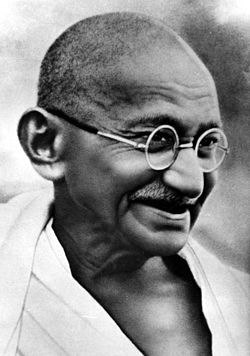
First non-co-operation movement[edit]
From 1920 to 1922, Gandhi started the Non-Cooperation Movement. At the Kolkata session of the Congress in September 1920, Gandhi convinced other leaders of the need to start a non-co-operation movement in support ofKhilafatas well as for dominion status. The first satyagraha movement urged the use ofkhadiand Indian material as alternatives to those shipped from Britain. It also urged people to boycott British educational institutions and law courts, resign from government employment, refuse to pay taxes, and forsake British titles and honors. Although this came too late to influence the framing of the newGovernment of India Act 1919,the movement enjoyed widespread popular support, and the resulting unparalleled magnitude of disorder presented a serious challenge to foreign rule. However, Gandhi called off the movement because he was scared after theChauri Chaura incident,which saw the death of twenty-two policemen at the hands of an angry mob that India would descend into anarchy.
Membership in the party was opened to anyone prepared to pay a token fee, a hierarchy of committees was established, made responsible for discipline and control over a hitherto amorphous and diffuse movement. The party was transformed from an elite organisation to one of mass national appeal and participation.[vague]
Gandhi was sentenced in 1922 to six years in prison, but was released after serving two. On his release from prison, he set up theSabarmati AshraminAhmedabad.On the banks of the riverSabarmati,he established the newspaperYoung India,introducing a series of reforms aimed at the socially disadvantaged within Hindu society — the rural poor, and theuntouchables.[96][97]This era saw the emergence of a new generation of Indians from within the Congress Party, includingMaulana Azad,C. Rajagopalachari,Jawaharlal Nehru,Vallabhbhai Patel,Subhas Chandra Boseand others- who would, later on, come to form the most prominent voices of the Indian self-rule movement, whether keeping with Gandhian Values, or, as in the case of Bose'sIndian National Army,diverging from it.
The Indian political spectrum was further broadened in the mid-1920s by the emergence of both moderate and militant parties, such as theSwaraj Party,Hindu Mahasabha,Communist Party of Indiaand theRashtriya Swayamsevak Sangh.Regional political organisations also continued to represent the interests of non-BrahminsinMadras,MaharsinMaharashtra,andSikhsin Punjab. However, people like MahakaviSubramanya Bharathi,Vanchinathan,and Neelakanda Brahmachari played a major role from Tamil Nadu in both self-rule struggle and fighting for equality for all castes and communities. Many women participated in the movement, including Kasturba Gandhi (Gandhi's wife),Rajkumari Amrit Kaur,Muthulaxmi Reddy,Aruna Asaf Ali,and many others.

Result of movements by Gandhi[edit]
The mass movements sparked nationalist sentiment with the Indian populace and figures like Mahatma Gandhi united a nation behind his non-violence movement; philosophy and undoubtedly put crucial pressure on the British occupation. The movements failed in their primary objective, achieving independence for India, as they were often called off before they naturally concluded due to laws and punishment. While in the later years of the Raj economic factors like the reversing trade fortunes between Britain and India and the cost of fielding the Indian armed forces abroad lumped on the British taxpayer by the 1935 Government of India act, had mounting implications for British administration, united resistance further drew light on the growing disparity of the British failures to achieve solidarity over India.
On 14 July 1942 theCongress Working Committee(executive committee of Indian National Congress), whose presidentAbul Kalam Azadsupported Gandhi, passed a resolution demanding complete independence from the British government, and proposed massive civil disobedience if the British did not accede to the demands. On 8 August 1942 theQuit India Movement(Bharat Chhodo Andolan) began, a civil disobedience movement in India in response to Mahatma Gandhi's call for immediate self-rule by Indians and against sending Indians to World War II. Other major parties rejected the Quit India plan, and most cooperated closely with the British, as did the princely states, the civil service, and the police. The Muslim League supported the Raj and grew rapidly in membership, and in influence with the British.
The British swiftly responded to theQuit India Movementwith mass arrests. Over 100,000 arrests were made, massive fines were levied, and demonstrators were subjected to public flogging. Hundreds of civilians were killed in violence many shot by the police army. Tens of thousands of leaders were also arrested and imprisoned until 1945. Ultimately, the British government realised that India was ungovernable in the long run, and the question for the postwar era became how to exit gracefully and peacefully.[98][99]
Purna Swaraj[edit]
-
C. Rajagopalachari,was an Indian nationalist who participated in the agitations against theRowlatt Act,joining theNon-cooperation movement,theVaikom Satyagraha,and theCivil disobedience movement.
-
V. K. Krishna Menonin 1928 foundedIndia Leaguein London and demanded total independence from the British rule.
-
Jawaharlal Nehruin 1929 demanded "complete independence from Great Britain."
-
Vallabhbhai Patel was appointed as the 49th President of Indian National Congress, organising the party for elections in 1934 and 1937 while promoting the Quit India Movement.
Congress leader and famous poetHasrat MohaniandCommunist Party of IndialeaderSwami Kumaranandhad demanded complete independence (Purna Swaraj) from the British in 1921 and put the resolution during an All-India Congress Forum at theAhmedabadSession ofAICC.[100]Maghfoor Ahmad Ajazisupported the 'Purna Swaraj' motion demanded by Hasrat Mohani.[101]
In 1928,India Leaguewas established byV. K. Krishna Menonin London to demand total independence from the British rule.[102][103]This organisation has been described as "the principal organisation promoting Indian nationalism in pre-war Britain".[104]
Following the rejection of theSimon Commission'srejections, an all-party conference was held atMumbaiin May 1928 to instill a sense of camaraderie. The conference appointed a committee underMotilal Nehruto create a constitution for India. The Kolkata session of the Indian National Congress asked the British government to accord India dominion status by December 1929, or face a countrywide civil disobedience movement.
Amid rising discontent and increasingly violent regional movements, a call for complete sovereignty and an end to British rule found greater support from the people. At theLahoresession in December 1929, the Indian National Congress adopted the aim of complete self-rule. It authorised the Working Committee to launch a civil disobedience movement throughout the country. It was decided that 26 January 1930 should be observed all over India as thePurna Swaraj(complete self-rule) Day.

TheGandhi–Irwin Pactwas signed in March 1931, and the government agreed to release political prisoners. Mahatma Gandhi managed to have over 90,000 political prisoners released under this pact.[105]Though his appeal to terminate the death sentences ofBhagat Singh,Sukhdev ThaparandShivaram Rajguruwas not accepted by the British. For the next few years, Congress and the government negotiated until theGovernment of India Act 1935emerged. The Muslim League disputed the claim of the Congress to represent all people of India, while the Congress disputed the Muslim League's claim to voice the aspirations of all Muslims. The Civil Disobedience Movement launched a new chapter in the Indian independence movement. It did not succeed by itself, but it brought the Indian population together, under the Indian National Congress's leadership. The movement resulted in self rule being a talking point once again, and recruited more Indians to the idea. The movement allowed the Indian independence community to revive their inner confidence and strength against the British Government. In addition, the movement weakened the authority of the British and aided in the end of the British Empire in India. Overall, the civil disobedience Movement was an essential achievement in the history of Indian self-rule because it persuaded New Delhi of the role of the masses inself-determination.[106]

Elections and the Lahore resolution[edit]
TheGovernment of India Act 1935,the voluminous and final constitutional effort at governingBritish India,articulated three major goals: establishing a loose federal structure, achieving provincial autonomy, and safeguarding minority interests through separate electorates. The federal provisions, intended to uniteprincely statesand British India at the centre, were not implemented because of ambiguities in safeguarding the existing privileges of princes. In February 1937, however, provincial autonomy became a reality when elections were held; the Congress emerged as the dominant party with a clear majority in five provinces and held an upper hand in two, while the Muslim League performed poorly.

In 1939, the ViceroyLinlithgowdeclared India's entrance into the Second World War without consulting provincial governments. In protest, the Congress asked all of its elected representatives to resign from the government.Muhammad Ali Jinnah,the president of theAll-India Muslim League,persuaded participants at the annual Muslim League session at Lahore in 1940 to adopt what later came to be known as theLahore Resolution,demanding the division of India into two separate sovereign states, one Muslim, the other Hindu; sometimes referred to asTwo Nation Theory.Although the idea of Pakistan had been introduced as early as 1930, very few had responded to it.
Inoppositionto the Lahore Resolution, theAll India Azad Muslim Conferencegathered in Delhi in April 1940 to voice its support for a united India.[107]Its members included several Islamic organisations in India, as well as 1400 nationalist Muslim delegates;[108][109]the "attendance at the Nationalist meeting was about five times than the attendance at the League meeting."[110]
The All-India Muslim League worked to try to silence those Muslims who stood against the partition of India, often using "intimidation and coercion".[110][109]The murder of the All India Azad Muslim Conference leaderAllah Bakhsh Soomroalso made it easier for the All-India Muslim League to demand the creation of Pakistan.[110]
Revolutionary movement[edit]
There is no real connection between these two unrests, labour, and Congress opposition. But their very existence and coexistence, explains and fully justifies the attention, which Lord Irwin gave to the labour problems.[111]
- -London Times,29 January 1928
Apart from a few stray incidents, armed rebellions against the British rulers did not occur before the beginning of the 20th century. The Indian revolutionary underground began gathering momentum through the first decade of the 20th century, with groups arising inBengal,Maharashtra,Odisha,Bihar,Uttar Pradesh,Punjab,and theMadras Presidencyincluding what is now calledSouth India.More groups were scattered around India. Particularly notable movements arose in Bengal, especially around thePartition of Bengalin 1905, and inPunjab after 1907.[112]In the former case, it was the educated, intelligent and dedicated youth of the urban middle classBhadralokcommunity that came to form the "classic" Indian revolutionary,[112]while the latter had an immense support base in the rural and military society of Punjab.
In Bengal, theAnushilan Samitiemergedfrom conglomerationsof local youth groups and gyms (Akhra) in Bengal in 1902, forming two prominent and somewhat independent arms inEastandWest Bengalidentified asDhaka Anushilan SamitiinDhaka(modern-dayBangladesh), and theJugantargroup (centred atCalcutta) respectively. Led by nationalists of the likes ofAurobindo Ghoshand his brotherBarindra Ghosh,theSamitiwas influenced by philosophies as diverse asHinduShaktaphilosophypropounded by Bengali literatureBankimandVivekananda,Italian Nationalism,andPan-AsianismofKakuzo Okakura.TheSamitiwas involved in a number of noted incidences of revolutionary terrorism against British interests and administration in India within the decade of its founding, includingearly attemptsto assassinate Raj officials whilst led by Ghosh brothers. In the meantime, in Maharashtra and Punjab arose similarly militant nationalist feelings. The District Magistrate ofNasik,A.M.T. Jacksonwas shot dead byAnant Kanherein December 1909, followed by the death ofRobert D'Escourt Asheat the hands ofVanchi Iyer.[113]
Indian nationalism made headway through Indian societies as far as Paris and London. In LondonIndia Houseunder the patronage ofShyamji Krishna Vermacame under increasing scrutiny for championing and justifying violence in the cause of Indian nationalism, which found in Indian students in Britain and from Indian expatriates inParis Indian Societyavid followers. By 1907, through Indian nationalistMadame Bhikaji Rustom Cama's links to Russian revolutionary Nicholas Safranski, Indian groups including Bengal revolutionaries as well as India House underV.D. Savarkarwere able to obtain manuals for manufacturing bombs. India House was also a source of arms and seditious literature that was rapidly distributed in India. In addition toThe Indian Sociologist,pamphlets likeBande MataramandOh Martyrs!by Savarkar extolled revolutionary violence. Direct influences and incitement from India House were noted in several incidents of political violence, including assassinations, in India at the time.[113][114][115]One of the two charges against Savarkar during his trial in Bombay was for abetting the murder of the District Magistrate of Nasik, A.M.T. Jackson, byAnant Kanherein December 1909. The arms used were directly traced through an Italian courier to India House. Ex-India House residents M.P.T. Acharya and V.V.S. Aiyar were noted in theRowlatt reportto have aided and influenced political assassinations, including the murder of Robert D'Escourt Ashe.[113]The Paris-Safranski link was strongly suggested by French police to be involved in a 1907 attempt in Bengal to derail the train carrying the Lieutenant-GovernorSir Andrew Fraser.[116]
-
Shyamji Krishna Varma,who founded theIndian Home Rule Society,India HouseandThe Indian SociologistinLondon.
-
Madan Lal Dhingra,while studying in England,assassinatedWilliam Hutt Curzon Wyllie,[117]a British official who was "old unrepentant foes of India who have fattened on the misery of the Indian peasant every [sic] since they began their career".[118]
-
V. V. S. Aiyarsubscribed to the militant form of resistance against the British.
-
Pandurang Mahadev Bapat,acquired the title ofSenapati,meaningcommander,as a consequence of his leadership during the Mulshi Satyagraha.[119]
-
Chandra Shekhar Azadreorganised the Hindustan Republican Association under its new name ofHindustan Socialist Republican Army(HSRA) after the death of its founder,Ram Prasad Bismil.
The activities of nationalists abroad is believed to have shaken the loyalty of a number of native regiments of theBritish Indian Army.[120]The assassination ofWilliam Hutt Curzon Wylliein the hands ofMadanlal Dhingrawas highly publicised and saw increasing surveillance and suppression of Indian nationalism.[121]These were followed by the1912 attempton the life of Viceroy of India. Following this, the nucleus of networks formed inIndia House,theAnushilan Samiti,nationalists in Punjab, and the nationalism that arose among Indian expatriates and labourers in North America, a different movement began to emerge in the North AmericanGhadar Party,culminating in theSedetious conspiracyof World War I led byRash Behari BoseandLala Hardayal.

However, the emergence of the Gandhian movement slowly began to absorb the different revolutionary groups. The BengalSamitimoved away from its philosophy of violence in the 1920s, when a number of its members identified closely with theCongressand Gandhian non-violent movement. Revolutionary nationalist violence saw a resurgence after the collapse of Gandhian non-cooperation movement in 1922. In Bengal, this saw reorganisation of groups linked to theSamitiunder the leadership ofSurya SenandHem Chandra Kanungo.A spate of violence led up to the enactment of theBengal Criminal Law Amendmentin the early 1920s, which recalled the powers of incarceration and detention of the Defence of India Act. In north India, remnants of Punjab and Bengalee revolutionary organisations reorganised, notably underSachindranath Sanyal,founding theHindustan Republican AssociationwithChandrashekhar Azadin north India.
The HSRA had strong influences from leftist ideologies.Hindustan Socialist Republican Association(HSRA) was formed under the leadership ofChandrasekhar Azad.Kakori train robberywas done largely by the members of HSRA. A number of Congress leaders from Bengal, especiallySubhash Chandra Bose,were accused by the British Government of having links with and allowing patronage to the revolutionary organisations during this time. The violence and radical philosophy revived in the 1930s, when revolutionaries of theSamitiand the HSRA were involved in theChittagong armoury raidand theKakori conspiracyand other attempts against the administration in British India and Raj officials.Sachindra Nath Sanyalmentored revolutionaries in theHindustan Socialist Republican Army(HSRA), including Bhagat Singh andJatindra Nath Das,among others; including arms training and how to make bombs.[122]Bhagat SinghandBatukeshwar Duttthrew a bomb inside theCentral Legislative Assemblyon 8 April 1929 protesting against the passage of the Public Safety Bill and the Trade Disputes Bill while raising slogans of "Inquilab Zindabad",though no one was killed or injured in the bomb incident. Bhagat Singh surrendered after the bombing incident and a trial was conducted. Sukhdev and Rajguru were also arrested by police during search operations after the bombing incident. Following the trial (Central Assembly Bomb Case), Bhagat Singh,SukhdevandRajguruwere hanged in 1931.Allama MashriqifoundedKhaksar Tehreekin order to direct particularly the Muslims towards the self-rule movement.[123]Some of its members left for the Indian National Congress then led by Subhas Chandra Bose, while others identified more closely withCommunism.TheJugantarbranch formally dissolved in 1938. On 13 March 1940,Udham SinghshotMichael O'Dwyer(the last political murder outside India), generally held responsible for theAmritsar Massacre,in London. However, the revolutionary movement gradually disseminated into the Gandhian movement. As the political scenario changed in the late 1930s — with the mainstream leaders considering several options offered by the British and with religious politics coming into play — revolutionary activities gradually declined. Many past revolutionaries joined mainstream politics by joiningCongressand other parties, especiallycommunist ones,while many of the activists were kept under hold in different jails across the country. Indians who were based in the UK, joinedthe India Leagueand theIndian Workers Association,partaking in revolutionary activities in Britain.[124]
Within a short time of its inception, these organisations became the focus of an extensive police and intelligence operations. Operations againstAnushilan Samitisaw founding of theSpecial BranchofCalcutta Police.The intelligence operations against India House saw the founding of theIndian Political Intelligence Officewhich later grew to be the Intelligence Bureau in independent India. Heading the intelligence and missions against Ghadarite movement and India revolutionaries was theMI5(g)section, and at one point involved thePinkerton'sdetective agency. Notable officers who led the police and intelligence operations against Indian revolutionaries, or were involved in it, at various time includedJohn Arnold Wallinger,Sir Robert Nathan,Sir Harold Stuart,Vernon Kell,Sir Charles Stevenson-MooreandSir Charles Tegart,as well asW. Somerset Maugham.The threat posed by the activities of theSamitiin Bengal duringWorld War I,along with the threat of aGhadarite uprising in Punjab,saw the passage ofDefence of India Act 1915.These measures saw the arrest, internment, transportations, and execution of a number of revolutionaries linked to the organisation, and was successful in crushing the East Bengal Branch. In the aftermath of the war, theRowlatt committeerecommended extending the Defence of India Act (as theRowlatt act) to thwart any possible revival of theSamitiin Bengal and the Ghadarite movement in Punjab.
In the 1920s,Alluri Sitarama Rajuled the ill-fatedRampa Rebellion of 1922–24, during which a band of tribal leaders and other sympathisers fought against the British Raj. Local people referred to him as "Manyam Veerudu" ( "Hero of the Jungles" ). After the passage of the 1882 Madras Forest Act, its restrictions on the free movement of tribal peoples in the forest prevented them from engaging in their traditionalpodu(Slash-and-burn) agricultural system, which involvedshifting cultivation.Raju started a protest movement in the border areas of the Godavari Agency part ofMadras Presidency(present-dayAndhra Pradesh). Inspired by the patriotic zeal of revolutionaries in Bengal, Raju raided police stations in and aroundChintapalle,Rampachodavaram,Dammanapalli,Krishna Devi Peta,Rajavommangi,Addateegala,NarsipatnamandAnnavaram.Raju and his followers stole guns and ammunition and killed severalBritish Indian Armyofficers, including Scott Coward nearDammanapalli.[125]The British campaign lasted for nearly a year from December 1922. Raju was eventually trapped by the British in the forests of Chintapalli then tied to a tree and shot dead with a rifle.[125]
TheKallara-Pangode Strugglewas one of some 39 agitations against the Government of India. The Home department has later notified about 38 movements/struggles across Indian territories as the ones that culminated in self-rule ended theBritish Raj.
-
Jatindra Nath Daswas arrested for revolutionary activities and wasimprisonedin Lahore jail to be tried under the supplementaryLahore Conspiracy Caseand died inLahore jailafter a 63-dayhunger strike.
-
Chempakaraman Pillaiwas involved in theHindu-German Conspiracyalong with theGhadar Partyin the United States.
-
Surya Sen,best known for leading the 1930Chittagong armoury raid.
-
Bhikaiji Cama,raised "Flag of Indian Independence" in Stuttgart, Germany.
Vanchinathan,in a letter found in his pocket, stated the following:
I dedicate my life as a small contribution to my motherland. I am alone responsible for this.
Themlechasof England having captured our country, tread over theSanatana Dharmaof the Hindus and destroy them. Every Indian is trying to drive out the English and getswarajyamand restore Sanatana Dharma. Our Raman, Sivaji, Krishnan, Guru Govindan, Arjuna ruled our land protecting all dharmas, but in this land, they are making arrangements to crown George V, amlecha,and one who eats the flesh of cows.
Three thousandMadraseeshave taken a vow to kill George V as soon as he lands in our country. In order to make others know our intention, I who am the least in the company, have done this deed this day. This is what everyone in Hindustan should consider it as his duty.
I will kill Ashe, whose arrival here is to celebrate the crowning of cow-eater King George V in this glorious land which was once ruled by greatSamrats.This I do to make them understand the fate of those who cherish the thought of enslaving this sacred land. I, as the least of them, wish to warn George by killing Ashe.
Vande Mataram.Vande Mataram. Vande Mataram
Final process of Indian self-rule movement[edit]
-
Ram Prasad Bismil Udyan (Park) inGreater Noida,was dedicated toRam Prasad Bismil,who participated inMainpuriconspiracy of 1918, and theKakori conspiracyof 1925, and struggled againstBritish imperialism.
-
Rajendra Lahiriwas the mastermind behindKakori conspiracyand Dakshineshwar bombing.
-
Bhagwati Charan Vohra,died inLahore[126]on 28 May 1930 while testing a bomb on the banks of theRiver Ravi.
In 1937,provincial electionswere held and the Congress came to power in seven of the eleven provinces. This was a strong indicator of the Indian people's support for complete self-rule.
When the Second World War started,Viceroy Linlithgowunilaterally declared India a belligerent state on the side of Britain, without consulting the elected Indian representatives. In opposition to Linlithgow's action, the entire Congress leadership resigned from the provincial and local governments. The Muslims and Sikhs, by contrast, strongly supported the war effort and gained enormous stature in London. Defying Congress, millions of Indians supported the war effort, and indeed theBritish Indian Armybecame the largest volunteer force, numbering 2,500,000 men during the war.[127]
-
National celebration at the founding of the Provisional National Indian government at the Free India Center, Berlin, withSecretary of StateWilhelm Kepplerspeaking, on 16 November 1943.
-
Greater East Asia Conferencein November 1943, participants left to right:Ba Maw,Zhang Jinghui,Wang Jingwei,Hideki Tojo,Wan Waithayakon,José P. Laurel,Subhas Chandra Bose.
-
Unreleased postage stampsof the Azad Hind government.
-
Lal Bahadur Shastri,was sent to prison for one year, for offering individualSatyagrahasupport to the independence movement.[128]
Especially during theBattle of Britainin 1940, Gandhi resisted calls for massive civil disobedience movements that came from within as well as outside his party, stating he did not seek India's self-rule out of the ashes of a destroyed Britain. In 1942, the Congress launched theQuit Indiamovement. There was some violence but the Raj cracked down and arrested tens of thousands of Congress leaders, including all the main national and provincial figures. They were not released until the end of the war was in sight in 1945.
The self-rule movement included theKakori conspiracy(9 August 1925) led by Indian youth under the leadership ofPandit Ram Prasad Bismiland masterminded byRajendra Lahiri;and theAzad Hindmovement, whose main protagonistNetaji Subhas Chandra Bosewas a former leader of Congress. From its earliest wartime inception, Bose joined theAxis Powersto fight Britain.

Quit India Movement[edit]
The Quit India Movement (also known asBharat Chhodo Andolan) was acivil disobediencemovement in India which commenced on 8 August 1942 in response toGandhi's call for immediate self-rule by Indians and against sending Indians to World War II. He asked all teachers to leave their schools, and other Indians to leave their respective jobs and take part in this movement. Due to Gandhi's political influence, his request was followed by a significant proportion of the population. In addition, Congress-led the Quit India Movement to demand the British to leave India and transfer the political power to a representative government.
During the movement, Gandhi and his followers continued to use non-violence against British rule. This movement was where Gandhi gave his famous message, "Do or Die!", and this message spread towards the Indian community. In addition, this movement was addressed directly to women as "disciplined soldiers of Indian freedom" and they had to keep the war for independence to go on (against British rule).

At the outbreak of war, the Congress Party had during the Wardha meeting of the working-committee in September 1939, passed a resolution conditionally supporting the fight against fascism,[129]but were rebuffed when they asked for self-rule in return. In March 1942, faced with an increasingly dissatisfied sub-continent only reluctantly participating in the war, and deteriorations in the war situation in Europe andSouth East Asia,and with growing dissatisfactions among Indian troops- especially in Europe- and among the civilian population in the sub-continent, the British government sent a delegation to India underStafford Cripps,in what came to be known as theCripps' Mission.The purpose of the mission was to negotiate with the Indian National Congress a deal to obtain total co-operation during the war, in return of progressive devolution and distribution of power from the crown and theViceroyto elected Indian legislature. However, the talks failed, having failed to address the key demand of a timeframe towards self-government, and of the definition of the powers to be relinquished, essentially portraying an offer of limited dominion-status that was wholly unacceptable to the Indian movement.[130]To force the British Raj to meet its demands and to obtain definitive word on total self-rule, the Congress took the decision to launch the Quit India Movement.
The aim of the movement was to force the British Government to the negotiating table by holding the Allied war effort hostage. The call for determined butpassive resistancethat signified the certitude that Gandhi foresaw for the movement is best described by his call toDo or Die,issued on 8 August at theGowalia TankMaidan in Bombay, since renamedAugust Kranti Maidan(August Revolution Ground). However, almost the entire Congress leadership, and not merely at the national level, was put into confinement less than 24 hours after Gandhi's speech, and the greater number of the Congress were to spend the rest of the war in jail.
On 8 August 1942, the Quit India resolution was passed at the Mumbai session of the All India Congress Committee (AICC). The draft proposed that if the British did not accede to the demands, a massive Civil Disobedience would be launched. However, it was an extremely controversial decision. At Gowalia Tank,Mumbai,Gandhi urged Indians to follow non-violent civil disobedience. Gandhi told the masses to act as citizens of a sovereign nation and not to follow the orders of the British. The British, already alarmed by the advance of the Japanese army to the India–Burma border, responded the next day by imprisoning Gandhi at theAga Khan PalaceinPune.The Congress Party's Working Committee, or national leadership was arrested all together and imprisoned at the Ahmednagar Fort. They also banned the party altogether. All the major leaders of the INC were arrested and detained. As the masses were leaderless the protest took a violent turn. Large-scale protests and demonstrations were held all over the country. Workers remained absent en masse and strikes were called. The movement also saw widespread acts of sabotage, Indian under-ground organisation carried out bomb attacks on allied supply convoys, government buildings were set on fire, electricity lines were disconnected and transport and communication lines were severed. The disruptions were under control in a few weeks and had little impact on the war effort. The movement soon became a leaderless act of defiance, with a number of acts that deviated from Gandhi's principle of non-violence. In large parts of the country, the local underground organisations took over the movement.
All the other major parties rejected the Quit India plan, and most cooperated closely with the British, as did the princely states, the civil service, and the police. TheMuslim Leaguesupported the Raj and grew rapidly in membership, and in influence with the British.[citation needed]
There was opposition to the Quit India Movement from several political quarters who were fighting for Indian self-rule. Hindu nationalist parties like theHindu Mahasabhaopenly opposed the call and boycotted the Quit India Movement.[131]Vinayak Damodar Savarkar,the president of the Hindu Mahasabha at that time, even went to the extent of writing a letter titled "Stick to your Posts", in which he instructed Hindu Sabhaites who happened to be "members of municipalities, local bodies, legislatures or those serving in the army...to stick to their posts" across the country, and not to join the Quit India Movement at any cost.[131]
The other Hindu nationalist organisation, and Mahasabha affiliateRashtriya Swayamsevak Sangh(RSS) had a tradition of keeping aloof from the anti-British Indian self-rule movement since its founding byK.B. Hedgewarin 1925. In 1942, the RSS, underM.S. Golwalkarcompletely abstained from joining in the Quit India Movement as well. The Bombay government (British) appreciated the RSS as such, by noting that,
The Sangh has scrupulously kept itself within the law, and in particular, has refrained from taking part in the disturbances that broke out in August 1942.[132]
The British Government stated that the RSS was not at all supporting any civil disobedience against them, and as such their other political activities(even if objectionable) can be overlooked.[133]Further, the British Government also asserted that at Sangh meetings organised during the times of anti-British movements started and fought by the Indian National Congress,
Speakers urged the Sangh members to keep aloof from the congress movement and these instructions were generally observed.[133]
As such, the British government did not crackdown on the RSS and Hindu Mahasabha at all.
The RSS head (sarsanghchalak) during that time,M.S. Golwalkarlater openly admitted to the fact that the RSS did not participate in the Quit India Movement. However, such an attitude during the Indian independence movement also led to the Sangh being viewed with distrust and anger, both by the general Indian public, as well as certain members of the organisation itself. In Golwalkar's own words,
In 1942 also, there was a strong sentiment in the hearts of many. At that time too, the routine work of the Sangh continued. Sangh decided not to do anything directly. 'Sangh is the organisation of inactive people, their talks have no substance' was the opinion uttered not only by outsiders but also our ownswayamsevaks.[134][135]
A number of violent incidents against British officials also took place during the Quit India movement around the country. The British arrested tens of thousands of leaders, keeping them imprisoned until 1945. Ultimately, the British government realised that India was ungovernable in the long run, and the question for the postwar era became how to exit gracefully and peacefully.
Others[edit]
-
Sikh soldiers of theIndian Legionguarding theAtlantic Wallin France in March 1944.
India's entry into the war was strongly opposed bySubhas Chandra Bose.Bose had been elected President of the Congress in 1938 and 1939 but later resigned owing to differences of opinion with Gandhi, however he remained emotionally attached to Congress for the remainder of his life. After his resignation he formed his own wing separated from the mainstream Congress leadership known asForward blocwhich was alocifocus for ex-congress leaders holding socialist views.[136]Bose then founded theAll India Forward Bloc.In 1940 the British authorities in Calcutta placed Bose under house arrest. However, he escaped and made his way throughAfghanistantoNazi Germanyto seekHitler and Mussolini'shelp for raising an army to fight the British. TheFree India LegioncomprisingErwin Rommel's IndianPOWswas formed. After a dramatic decline in Germany's military fortunes, a German land invasion of India became untenable. Hitler advised Bose to go to Japan where a submarine was arranged to transport Bose, who was ferried to Japanese Southeast Asia, where he formed theAzad Hind Government.The Provisional Free Indian Government in exile reorganised theIndian National Armycomposed of Indian POWs and volunteer Indianexpatriatesin South-East Asia, with the help of the Japanese. Its aim was to reach India as a fighting force that would build on public resentment to inspire revolt among Indian soldiers of the Raj.
The INA was to see action against the Allies, including theBritish Indian Army,in the forests of Arakan,Burma,and inAssam,layingsiege to Imphal and Kohimawith theJapanese 15th Army.During the war, theAndaman and Nicobarislandswere captured by the Japaneseand handed over by them to the INA.
While a number of Japanese officers, even those likeFujiwara,who were devoted to the Indian cause, observed Bose as a military incompetent as well as an unrealistic and stubborn man who sees only his own needs and problems and could not observe the larger picture of the war as the Japanese had to.[137]
The INA failed owing to disrupted logistics, poor supplies from the Japanese, and lack of training.[138]The Azad Hind Fauj surrendered unconditionally to the British in Singapore in 1945. In the consensus of scholarly opinion,Subhas Chandra Bose's deathoccurred from third-degree burns on 18 August 1945 after his overloaded Japanese plane crashed in Japanese-ruled Formosa (now Taiwan).
Trials against members of the INAbegan in late 1945, and included the infamous joint court-martial of key figuresShah Nawaz KhanandPrem Sahgal.

TheRoyal Indian Navy Mutinywas a failed insurrection which encompassed atotal strikeand subsequentmutinyby Indian sailors of the Royal Indian Navy on board ship and shore establishments at Bombay (Mumbai) harbour on 18 February 1946. From the initial flashpoint in Bombay, the mutiny spread and found support throughoutBritish India,fromKarachitoCalcuttaand ultimately came to involve 78 ships, 20 shore establishments and 20,000 sailors.[139]
The agitations, mass strikes, demonstrations and consequently support for the mutineers, therefore continued several days even after the mutiny had been called off. Along with this, the assessment may be made that it described in crystal clear terms to the government that theBritish Indian Armed forcescould no longer be universally relied upon for support in crisis, and even more it was more likely itself to be the source of the sparks that would ignite trouble in a country fast slipping out of the scenario of political settlement.[140]
The mutiny ended with the surrender of revolting the sailors to British officials. Congress and the Muslim League had convinced Indian sailors to surrender. They condemned the mutiny due to the political and military risks of unrest.
Impact of World War II[edit]
World War IIwas one of the most significant factors in accelerating Indian independence, and the independence of many British and non-British colonies. In the period 1945–1965,decolonisationled to more than three dozen countries getting freedom from their colonial powers.[141]Many factors contributed to the downfall of the British Empire.
When Britain reached out to the US asking for help in the war, the US offered help contingent on Britain decolonizing post-WWII, and that agreement was codified in theAtlantic Charter.The decolonisation of the British Empire (post-war) also meant that the US and other countries could possibly have access to markets to sell goods that were previously under the British Empire – which were not accessible to them then.[142][143]To bring about these changes, the establishment of the UN following WWII codified sovereignty for nations, and encouraged free trade. The war also forced the British to come to an agreement with Indian leaders to grant them independence if they helped with war efforts since India had one of the largest armies.[144]Also, following WWII, it was untenable for Britain to raise capital on its own to keep its colonies. They needed to rely on America and did so via theMarshall Planto rebuild their country.

Sovereignty and partition of India[edit]
On 3 June 1947, ViscountLouis Mountbatten,the last BritishGovernor-General of India,announced the partitioning of British India intoIndiaandPakistan.With the speedy passage of theIndian Independence Act 1947,at 11:57 on14 August 1947Pakistan was declared a separate nation. Then at 12:02 A.M., on15 August 1947India became a sovereign and democratic nation. Eventually, 15 August became Independence Day for India marking the end of British India. Also on 15 August, both Pakistan and India had the right to remain in or remove themselves from theBritish Commonwealth.But in 1949, India took the decision to remain in the commonwealth.
Violent clashes between Hindus, Sikhs, and Muslims followed. Prime MinisterJawaharlal Nehruand deputy prime ministerVallabhbhai Patelhad invited Mountbatten to continue asGovernor General of Indiaduring the period of transition. He was replaced in June 1948 byRajagopalachari.In May 1947, Nehru declared that anyprincely statewhich refused to join theConstituent Assemblywould be treated as an enemy state. Patel took on the responsibility for bringing princely states into the Union of India, steering efforts by his "iron fist in a velvet glove" policies. There was the use of military force to integrateJunagadh,Hyderabad State(Operation Polo) andKashmir(Instrument of Accession) to India.[145]
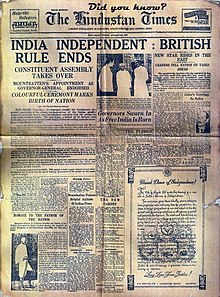
TheConstituent Assembly,headed by the prominent lawyer, reformer and Dalit leader, B.R. Ambedkar was tasked heading the creation of the constitution of independent India, and the constitution was drafted byB. N. Rau.The Constituent Assembly completed the work of drafting the constitution on 26 November 1949; on 26 January 1950, theRepublic of Indiawas officially proclaimed. The Constituent Assembly electedRajendra Prasadwas the firstPresident of India,taking over from Governor General Rajgopalachari. Subsequently, the French cededChandernagorein 1951, andPondichéryand its remaining Indian colonies by 1954. Indian troopsannexed Goaand Portugal's otherIndian enclavesin 1961, andSikkimvotedto join the Indian Union in 1975 after theIndian victory over Chinain Nathu La and Cho La.
Following self-rule in 1947, India remained in theCommonwealth of Nations,andrelations between the UK and Indiahave since become friendly. There are many areas in which the two countries seek stronger ties for mutual benefit, and there are also strong cultural and social ties between the two nations. The UK has an ethnic Indian population of over 1.6 million. In 2010, Prime MinisterDavid Camerondescribed Indian – British relations as a "NewSpecial Relationship".[146]
See also[edit]
- Partition of India
- Partition of Bengal (1947)
- Independence Day (India)
- Independence Day (Pakistan)
- Revolutionary movement for Indian independence
- Women of the Indian independence movement
- Communist involvement in Indian Independence movement
Notes[edit]
- ^TheEnglish colonial empire,including the territories and trading post in Asia, came underBritishcontrol following theunion of England and Scotland in 1707.
References[edit]
Citations[edit]
- ^Zakaria, Anam."Remembering the war of 1971 in East Pakistan".Al Jazeera.Retrieved18 May2020.
- ^"Vasco da Gama reaches India".History.Retrieved18 May2020.
- ^Heehs 1998,p. 9
- ^Heehs 1998,pp. 9–10
- ^Heehs 1998,pp. 11–12
- ^"Sikh Wars | Indian history".Encyclopædia Britannica.Retrieved18 May2020.
- ^"P Chidambaram releases documentary film on Alagumuthu Kone | Madurai News".The Times of India.Retrieved1 October2020.
- ^abcdHoro, Albert (2013)."Jharkhand Movement"(PDF).International Journal of Humanities and Social Science Invention.2(4): 1–6 – via Google Scholar.
- ^abGupta, Sanjukta Das; Basu, Raj Sekhar (2012).Narratives from the Margins: Aspects of Adivasi History in India.Primus Books.ISBN978-93-80607-10-8.
- ^"Summary of the Tribal Rebellions during British rule in India".Jagranjosh.20 March 2018.Retrieved21 November2021.
- ^Lees, James (2015)."'A Character to lose': Richard Goodlad, the Rangpur dhing, and the priorities of the East India Company's early colonial administrators ".Journal of the Royal Asiatic Society.25(2): 301–315.ISSN1356-1863.JSTOR43307694.
- ^abGupta, Sanjukta Das (2011).Adivasis and the Raj: Socio-economic Transition of the Hos, 1820–1932.Orient Blackswan.ISBN978-81-250-4198-6.
- ^Kumar, Akshay (18 June 2021)."Ho Rebellion & Kol Rebellion | Jharkhand".Edvnce.Retrieved21 November2021.
- ^Jha, Jagdish Chandra (1 January 1967).The Bhumij Revolt (1832–33): (ganga Narain's Hangama Or Turmoil).Munshiram Manoharlal Publishers Pvt. Ltd.ISBN978-81-215-0353-2.
- ^Khan, Muazzam Hussain. "Titu Mir". Banglapedia. Bangladesh Asiatic Society. Retrieved 4 March 2014.
- ^Jha, Jagdish Chandra (1958)."The Kol Rising of Chotanagpur (1831–33) – Its Causes".Proceedings of the Indian History Congress.21:440–446.ISSN2249-1937.JSTOR44145239.
- ^This is our homeland... a collection of essays on the betrayal of Adivasi rights in India.Bangalore: Equations. 2007.
- ^Soren, Nayan (30 June 2020)."Remembering Santal Hul: A quest for Indigenous sovereignty".Adivasi Resurgence.Retrieved21 November2021.
- ^"The Forgotten Santhal Revolt of 1855".Live History India.Retrieved21 November2021.
- ^"Remembering Santal Hul, a 19th Century Struggle Against Imperialism".The Wire.Retrieved21 November2021.
- ^abSingh, Kumar Suresh (2002).Birsa Munda and His Movement, 1872–1901: A Study of a Millenarian Movement in Chotanagpur.Seagull Books.ISBN978-81-7046-205-7.
- ^abcA.K.Dhan (2017).Birsa Munda.Publications Division Ministry of Information & Broadcasting.ISBN978-81-230-2544-5.
- ^"About Birsa Munda [ 1875-1900 ] Biography & Life History".The Ambedkarite Today – Voice Of Voiceless.15 November 2019.Retrieved21 November2021.
- ^abc"The 'Ulgulaan' of 'Dharti Aba – Birsa Munda'".Adivasi Resurgence.9 June 2016.Retrieved21 November2021.
- ^"East India Company – Definition, History, & Facts".Encyclopædia Britannica.2023.
- ^"Remembering Queen Velu Nachiyar of Sivagangai, the first queen to fight the British".The News Minute.3 January 2017.
- ^"Velu Nachiyar, Jhansi Rani of Tamil Nadu".The Times of India.17 March 2016.
- ^"Legends from South".Archived fromthe originalon 4 September 2012.
- ^Yang, Anand A. (November 2007). "Bandits and Kings: Moral Authority and Resistance in Early Colonial India".The Journal of Asian Studies.66(4): 881–896.doi:10.1017/s0021911807001234.JSTOR20203235.
- ^K. Guru Rajesh (2015).Sarfarosh: A Naadi Exposition of the Lives of Indian Revolutionaries.Notion Press. p. 65.ISBN978-93-5206-173-0.
- ^"Chinnamalai, a lesser-known freedom fighter of Kongu soil".The Hindu.2 August 2008. Archived fromthe originalon 14 September 2008.
- ^Govardhan, Ram (2001).Rough with the Smooth.Leadstart Publishing. p. 212.ISBN9789381115619.
- ^Rout, Hemant Kumar (2012)."Villages fight over martyr's death place".The New Indian Express.Archived fromthe originalon 6 May 2014.Retrieved7 February2013.
historians claim he is actually the first martyr in the country's freedom movement because none was killed by the Britishers before 1806
- ^Mohanty, N.R. (August 2008)."The Oriya Paika Rebellion of 1817"(PDF).Orissa Review:1–3. Archived fromthe original(PDF)on 11 November 2013.Retrieved13 February2013.
- ^Paikaray, Braja (February–March 2008)."Khurda Paik Rebellion – The First Independence War of India"(PDF).Orissa Review:45–50. Archived fromthe original(PDF)on 22 April 2014.Retrieved13 February2013.
- ^"Paik Rebellion".Khordha.National Informatics Centre.Retrieved14 August2018.
- ^abChandra et al. 1989,p. 31
- ^Chandra et al. 1989,p. 33
- ^Chandra et al. 1989,pp. 33–34
- ^Chandra et al. 1989,p. 34
- ^"The Uprising of 1857".Library of Congress.Retrieved10 November2009.
- ^David 2002,p. 122
- ^Chandra et al. 1989,p. 35
- ^Chandra et al. 1989,pp. 38–39
- ^Chandra et al. 1989,p. 39
- ^Heehs 1998,p. 32
- ^"Official, India".World Digital Library.1890–1923.Retrieved30 May2013.
- ^Heehs 1998,pp. 47–48
- ^Heehs 1998,p. 48
- ^Robert P. O'Kell (2014).Disraeli: The Romance of Politics.U of Toronto Press. pp. 443–44.ISBN9781442661042.
- ^Nanda, B. R.(2015) [1977],Gokhale: The Indian Moderates and the British Raj,Legacy Series, Princeton University Press, p. 58,ISBN978-1-4008-7049-3
- ^abcdefMarshall, P. J. (2001),The Cambridge Illustrated History of the British Empire,Cambridge University Press, p. 179,ISBN978-0-521-00254-7Quote: "The first modern nationalist movement to arise in the non-European empire, and one that became an inspiration for many others, was the Indian Congress."
- ^Chhabra, G.S. (1963).Social and Economic History of the Panjab: (1849–1901).S. Nagin. pp. 129–130, 346.
- ^Wolpert, Stanley(1988)."The Indian National Congress in Nationalist Perspective".In Sisson, Richard; Wolpert, Stanley (eds.).Congress and Indian Nationalism: The Pre-independence Phase.University of California Press. p. 24.ISBN978-0-520-06041-8.
For the most part, however, Muslim India remained either aloof from or distrustful of the Congress and its demands.
- ^"Swaraj | Indian politics | Britannica".britannica.Retrieved11 March2023.
- ^Ramnath, Maia (2011).Haj to Utopia: How the Ghadar Movement Charted Global Radicalism and Attempted to Overthrow the British Empire.University of California Press. p. 227.ISBN978-0-520-26955-2.
- ^Latif, Asad (2008).India in the Making of Singapore.Singapore: Institute of Southeast Asian Studies. p. 34.ISBN9789810815394.
- ^Thomas, Abraham Vazhayil (1974).Christians in Secular India.Fairleigh Dickinson University Press. pp. 106–107.ISBN978-0-8386-1021-3.
- ^Thomas, Abraham Vazhayil (1974).Christians in Secular India.Fairleigh Dickinson University Press. pp. 107–108n.ISBN978-0-8386-1021-3.
- ^abOddie, Geoffrey A. (2001). "Indian Christians and National Identity 1870–1947".The Journal of Religious History.25(3): 357, 361.doi:10.1111/1467-9809.00138.
- ^Thomas, Abraham Vazhayil (1974).Christians in Secular India.Fairleigh Dickinson University Press. pp. 109–110.ISBN978-0-8386-1021-3.
- ^Blocker, Jack S.; Fahey, David M.; Tyrrell, Ian R. (2003).Alcohol and Temperance in Modern History: An International Encyclopedia.ABC-CLIO. p. 310.ISBN9781576078334.
- ^Fischer-Tiné & Tschurenev 2014,pp. 255–257
- ^abGuha, Arun Chandra (1971).First Spark of Revolution.Orient Longman. pp. 130–131.OCLC254043308.
They [Khudiram Basu and Prafulla Chaki] threw a bomb on a coach similar to that of Kingsford's... Khudiram... was sentenced to death and hanged.
- ^John R. McLane, "The Decision to Partition Bengal in 1905"Indian Economic and Social History Review,July 1965, 2#3, pp 221–237
- ^Patel 2008,p. 56
- ^The major charge... during the trial (1910–1911) was "conspiracy to wage war against the King-Emperor" and "tampering with the loyalty of the Indian soldiers" (mainly with the10th JatsRegiment) (cf:Sedition Committee Report,1918)
- ^Basu, Raj Sekhar (2012)."Basu, Benoy Krishna".InIslam, Sirajul;Jamal, Ahmed A. (eds.).Banglapedia: National Encyclopedia of Bangladesh(Second ed.).Asiatic Society of Bangladesh.
- ^Heehs 2008,p. 133
- ^Majumdar, R. C.Penal Settlement in Andamans.Delhi: Government of India. p. 339.
- ^Nandi, Soumitra (20 October 2017)."Story of Basanta Biswas, penned by Ujjal Biswas, to be portrayed on celluloid".millenniumpost.in.Retrieved15 March2022.
- ^Samaddar, Ranabir (1 August 2007).The Materiality of Politics: Volume 1: The Technologies of Rule.Anthem Press. pp. 76–77.ISBN978-1-84331-765-4.
- ^Hoda, Noorul (1 February 2008).The Alipore Bomb Case.Niyogi Books.ISBN978-81-89738-31-0.
- ^Sengupta, Nitish K. (2011).Land of Two Rivers: A History of Bengal from the Mahabharata to Mujib.Penguin Books India. p. 329.ISBN978-0-14-341678-4.
- ^Samanta,Vol. II, "Nixon's Report", p. 591.
- ^Jalal 1994,p. 4
- ^Official website, Government of Pakistan."The Statesman: Jinnah's differences with the Congress".Archived fromthe originalon 27 January 2006.Retrieved20 April2006.
- ^Gupta 1997,p. 12
- ^Popplewell 1995,p. 201
- ^Lawrence James,Raj: The Making and Unmaking of British India(2000) pp 439–518
- ^abPlowman 2003,p. 84
- ^abHoover 1985,p. 252
- ^abBrown 1948,p. 300
- ^Mukherjee 2010,p. 160
- ^Majumdar 1975,p. 281
- ^Hopkirk 1994,p. 179
- ^Wilkinson, Steven Ian (September–October 2000), "India, Consociational Theory, and Ethnic Violence",Asian Survey,40(5): 767–791,doi:10.2307/3021176,JSTOR3021176
- ^James,Raj: The Making and Unmaking of British India(2000) pp 459–60, 519–20
- ^Denis Judd,Empire: The British Imperial Experience From 1765 To The Present(pp. 226—411, 998)
- ^"The Indian Independence Movement".Retrieved29 May2014.
- ^Jallianwala Bagh Massacre
- ^Collett 2005,p. ix
- ^Lloyd 2011,p. 181
- ^Derek Sayer, "British Reaction to the Amritsar Massacre 1919–1920,"Past & Present,May 1991, Issue 131, pp 130–164
- ^Dennis Judd, "The Amritsar Massacre of 1919: Gandhi, the Raj and the Growth of Indian Nationalism, 1915–39," in Judd,Empire: The British Imperial Experience from 1765 to the Present(1996) pp 258- 72
- ^Sankar Ghose,Gandhi(1991) p. 107
- ^Sanjay Paswan and Pramanshi Jaideva,Encyclopaedia of Dalits in India(2003) p. 43
- ^Zachariah, Benjamin (1 March 2011)."Zachariah, 'Gandhi, Non-Violence and Indian Independence'".History Review.
- ^"Do or Die: The Quit India Movement of 1942".The Nonviolence Project.19 August 2021.Retrieved4 February2024.
- ^"Profile: Maulana Hasrat Mohani".The Milli Gazette (newspaper).6 October 2012.Retrieved11 March2019.
- ^Ministry of Culture, Government of India."Maghfoor Ahmad Ajazi".amritmahotsav.nic.in.
- ^V.K. Krishna Menon Remembered.Indian Society of International Law. 2005. p. 4.ISBN978-81-7827-133-0.
- ^Rana, K.S. (2022).Churchill and India: Manipulation or Betrayal?.Taylor & Francis. p. 65.ISBN978-1-000-72827-9.
- ^McGarr, Paul M. (2011). ""India's Rasputin"?: V. K. Krishna Menon and Anglo–American Misperceptions of Indian Foreign Policymaking, 1947–1964 ".Diplomacy & Statecraft.22(2): 239–260.doi:10.1080/09592296.2011.576536.ISSN0959-2296.
- ^Banglapedia: National Encyclopedia of Bangladesh, Volume 3, p. 36, Sirajul Islam, Asiatic Society of Bangladesh
- ^Greenough, Paul R. (1999). "Political mobilisation and the Underground Literature of the Quit Indian Movement, 1942–44".Social Scientist.27(7/8): 11–47.doi:10.2307/3518012.JSTOR3518012.
- ^Qasmi, Ali Usman; Robb, Megan Eaton (2017).Muslims against the Muslim League: Critiques of the Idea of Pakistan.Cambridge University Press. p. 2.ISBN9781108621236.
- ^Haq, Mushir U. (1970).Muslim politics in modern India, 1857-1947.Meenakshi Prakashan. p. 114.OCLC136880.
This was also reflected in one of the resolutions of the Azad Muslim Conference, an organisation which attempted to be representative of all the various nationalist Muslim parties and groups in India.
- ^abAhmed, Ishtiaq (27 May 2016)."The dissenters".The Friday Times.
However, the book is a tribute to the role of one Muslim leader who steadfastly opposed the Partition of India: the Sindhi leader Allah Bakhsh Soomro. Allah Bakhsh belonged to a landed family. He founded the Sindh People's Party in 1934, which later came to be known as 'Ittehad' or 'Unity Party'....Allah Bakhsh was totally opposed to the Muslim League's demand for the creation of Pakistan through a division of India on a religious basis. Consequently, he established the Azad Muslim Conference. In its Delhi session held during April 27–30, 1940 some 1400 delegates took part. They belonged mainly to the lower castes and working class. The famous scholar of Indian Islam, Wilfred Cantwell Smith, feels that the delegates represented a 'majority of India's Muslims'. Among those who attended the conference were representatives of many Islamic theologians and women also took part in the deliberations... Shamsul Islam argues that the All-India Muslim League at times used intimidation and coercion to silence any opposition among Muslims to its demand for Partition. He calls such tactics of the Muslim League as a 'Reign of Terror'. He gives examples from all over India including the NWFP where the Khudai Khidmatgars remain opposed to the Partition of India.
- ^abcAli, Afsar (17 July 2017)."Partition of India and Patriotism of Indian Muslims".The Milli Gazette.
- ^K̲h̲ān, Lāl (2007).Crisis in the Indian Subcontinent, Partition: Can it be Undone?.Aakar Books.ISBN9788189833107.
- ^abFraser 1977,p. 257
- ^abcYadav 1992,p. 4
- ^Hopkirk 1994,p. 46 [By 1909] India House was beginning to come under suspicion... too late to save Sir William Curzon Wyllie from the assassin's pistol... Savarkar could see that London was rapidly becoming too hot for him... In early January 1910, therefore, he slipped quietly over to Paris, determined to make it his new revolutionary headquarters... [police] managed to obtain evidence linking him with the smuggling of firearms into India.
- ^Majumdar 1966,p. 147 Savarkar'sBande Mataramcontained exhortations [advocating terrorism]... This sort of propaganda produced a natural effect. A. M. T. Jackson, the Magistrate... was shot dead on 21 December 1909... charges against him [Savarkar] included the sending of pistols and seditious pamphlets to India. Another charge was that in 1908 he with the help of residents in the India House manifolded in type a number of copies of a work describing minutely the manner of preparing explosives and bombs. He despatched these copies to various addresses in India.
- ^Popplewell 1995,p. 135
- ^Nehru, Jawaharlal; Nand Lal Gupta (2006).Jawaharlal Nehru on Communalism.Hope India Publications. p. 161.ISBN978-81-7871-117-1.
- ^Richard James Popplewell (1995).Intelligence and imperial defence: British intelligence and the defence of the Indian Empire, 1904–1924.Frank Cass. p. 143.ISBN978-0-7146-4580-3.Retrieved25 March2012.
- ^Cashman, Richard I. (1975).The Myth of the Lokamanya: Tilak and mass politics in Maharashtra.University of California. p.190.ISBN9780520024076.
- ^Lahiri 2000,p. 129
- ^"Dhingra, Madan Lal".Oxford Dictionary of National Biography.Oxford University Press. 2004.doi:10.1093/ref:odnb/71628.Retrieved29 October2015.
- ^Chatterji, Shoma A. (2015).Filming Reality: The Independent Documentary Movement in India.SAGE Publications India. p. 36.ISBN978-9-35150-543-3.
- ^Khaksar Tehrik Ki Jiddo Juhad Volume 1. Author Khaksar Sher Zaman
- ^Nasta, Susheila, ed. (2013).India in Britain: South Asian networks and connections, 1858–1950.New York: Palgrave Macmillan.ISBN978-0-230-39271-7.OCLC802321049.
- ^abBalakrishna, V.G."Freedom Movement in Andhra Pradesh".Government of India Press Information Bureau.Retrieved28 March2011.
- ^Firth, Colin; Arnove, Anthony (13 September 2012).The People Speak: Democracy is not a Spectator Sport.Canongate Books.ISBN9780857864475.
- ^Roy, Kaushik (2009). "Military Loyalty in the Colonial Context: A Case Study of the Indian Army during World War II".Journal of Military History.73(2): 144–172.doi:10.1353/jmh.0.0233.
- ^"Lal Bahadur Shastri: In Prison Again".Free India.Archived fromthe originalon 19 January 2007.Retrieved13 March2007.
- ^"The Congress and The Freedom Movement".Indian National Congress. Archived fromthe originalon 11 August 2007.Retrieved24 September2007.
- ^Culture and Combat in the Colonies. The Indian Army in the Second World War.Tarak Barkawi.J Contemn History. 41(2), 325–355.pp:332
- ^abBapu, Prabhu (2013).Hindu Mahasabha in Colonial North India, 1915–1930: Constructing Nation and History.Routledge. pp. 103–.ISBN978-0-415-67165-1.
- ^Bandyopadhyaya, Sekhara (2004).From Plassey to Partition: A History of Modern India.Orient Blackswan. p. 422.ISBN978-81-250-2596-2.
- ^abChandra 2008,p. 140
- ^Puniyani 2005,pp. 134–
- ^Islam, Shamsul (2006).Religious Dimensions of Indian Nationalism: A Study of RSS.Media House. pp. 187–.ISBN978-81-7495-236-3.
- ^Bose 1985
- ^Gordon, Leonard A.(1990).Brothers Against the Raj: A Biography of Indian Nationalists Sarat and Subhas Chandra Bose.New York and Oxford: Columbia University Press. p. 517.ISBN0-231-07443-3.
- ^"Forgotten armies of the East – Le Monde diplomatique – English edition".Mondediplo. 10 May 2005.Retrieved14 June2012.
- ^Notes on IndiaBy Robert Bohm.pp213
- ^James L.Raj; Making and unmaking of British India. Abacus. 1997. p571, p598and; Unpublished, Public Relations Office, London. War Office. 208/819A 25C
- ^"Milestones: 1945–1952 – Office of the Historian".
- ^William Roger Louis, Imperialism at Bay: The United States and the Decolonization of the British Empire, 1941–1945 (1978).
- ^Andrew N. Buchanan, "The War Crisis and the Decolonization of India, December 1941 – September 1942: A Political and Military Dilemma." Global War Studies 8#2 (2011): 5–31
- ^"BBC – History – British History in depth: Britain, the Commonwealth and the End of Empire".
- ^Mitra 1997,pp. 55–74
- ^Nelson, Dean (7 July 2010)."Ministers to build a new 'special relationship' with India".The Daily Telegraph.Archived fromthe originalon 21 July 2010.
Sources and further reading[edit]
- Amstutz, Andrew (27 May 2019). "Review essay: Alternative histories of revolutionaries in modern South Asia: context, chronology, and archives".India Review.18(3): 324–342.doi:10.1080/14736489.2019.1616262.S2CID199354334.
- Bose, Nirmal(October–December 1985). "Subhas Chandra Bose and the Indian National Congress".Indian Journal of Political Science.46(4): 438–450.JSTOR41855198.
- Brown, Giles (August 1948). "The Hindu Conspiracy, 1914–1917".The Pacific Historical Review.17(3): 299–310.doi:10.2307/3634258.JSTOR3634258.
- Chandra, Bipan;Mukherjee, Mridula; Mukherjee, Aditya; Mahajan, Sucheta;Panikkar, K. N.(1989).India's Struggle for Independence.New Delhi:Penguin Books.p. 600.ISBN978-0-14-010781-4.
- Chandra, Bipan(2008).Communalism in Modern India.Har-Anand. pp. 140–.ISBN978-81-241-1416-2.
- Collett, Nigel(2005).The Butcher of Amritsar: General Reginald Dyer.Hambledon Continuum.ISBN978-1-85285-457-7.
- David, Saul(2002).The Indian Mutiny: 1857.Viking. p. 122.ISBN978-0-670-91137-0.
- Fischer-Tiné, Harald;Tschurenev, Jana, eds. (2014).A History of Alcohol and Drugs in Modern South Asia: Intoxicating Affairs.Taylor & Francis. pp. 255–257.ISBN978-1-317-91681-9.
- Fraser, Thomas G. (April 1977). "Germany and Indian Revolution, 1914-18".Journal of Contemporary History.12(2): 255–272.doi:10.1177/002200947701200203.JSTOR260216.S2CID161813088.
- Ghosh, Durba.Gentlemanly Terrorists: Political Violence and the Colonial State in India, 1919-1947(Cambridge University Press, 2017.)
- Gupta, Amit Kumar (September–October 1997). "Defying Death: Nationalist Revolutionism in India, 1897–1938".Social Scientist.25(9/10): 3–27.doi:10.2307/3517678.JSTOR3517678.
- Heehs, Peter(1998).India's Freedom Struggle: A Short History.Delhi: Oxford University Press. p. 199.ISBN978-0-19-562798-5.
- Heehs, Peter(2008).The Lives of Sri Aurobindo.Columbia University Press.ISBN978-0-231-14098-0.
- Hoover, Karl (May 1985). "The Hindu Conspiracy in California, 1913–1918".German Studies Review.8(2): 245–261.doi:10.2307/1428642.JSTOR1428642.
- Hopkirk, Peter(1994).On Secret Service East of Constantinope.John Murray.ISBN978-0-7195-5017-1.
- Jalal, Ayesha(1994).The Sole Spokesman: Jinnah, the Muslim League and the Demand for Pakistan.Cambridge University Press.ISBN978-0-521-45850-4.
- Lahiri, Shompa (2000).Indians in Britain: Anglo-Indian Encounters, Race and Identity, 1880–1930.Psychology Press.ISBN978-0-7146-4986-3.
- Lloyd, Nick(2011).The Amritsar Massacre: The Untold Story of One Fateful Day.I.B. Tauris.ISBN978-1-84885-723-0.
- Maclean, Kama.A Revolutionary History of Interwar India: Violence, Image, Voice and Text(Oxford University Press, 2015.)
- Majumdar, Bimanbehari (1966).Militant nationalism in India and its socio-religious background (1897–1917).General Printers & Publishers.OCLC8793353.
- Majumdar, Ramesh C (1975).History of the Freedom Movement in India.Vol. II. Firma K. L. Mukhopadhyay.ISBN978-81-7102-099-7.
- Mitra, Subrata K.(July 1997). "Nehru's policy towards Kashmir: Bringing politics back in again".Journal of Commonwealth & Comparative Politics.35(2): 55–74.doi:10.1080/14662049708447745.
- Mukherjee, Prithwindra (2010).Les racines intellectuelles du mouvement d'indépendance de l'Inde (1893-1918).Editions Codex.ISBN978-2-918783-02-2.
- Patel, Hitendra (2008).Khudiram Bose: Revolutionary Extraordinaire.New Delhi: Publications Division, Ministry of Information and Broadcasting, Govt. of India.ISBN978-81-230-2278-9.
- Plowman, Matthew (Autumn 2003). "Irish Republicans and the Indo-German Conspiracy of World War I".New Hibernia Review.7(3): 81–105.doi:10.1353/nhr.2003.0069.S2CID144632198.
- Popplewell, Richard James (1995).Intelligence and Imperial Defence: British Intelligence and the Defence of the Indian Empire, 1904-1924.London, England: Frank Cass.ISBN978-0-7146-4580-3.
- Puniyani, Ram(2005).Religion, Power and Violence: Expression of Politics in Contemporary Times.SAGE Publications. pp. 134–.ISBN978-0-7619-3338-0.
Further reading[edit]
- Brown, Judith M.(1972).Gandhi's Rise to Power: Indian Politics 1915–1922.Cambridge South Asian Studies. Cambridge University Press.ISBN978-0-521-08353-9.
- Brown, Judith M.(2009). "Gandhi and Civil Resistance in India, 1917–47". InRoberts, Adam;Ash, Timothy Garton(eds.).Civil Resistance and Power Politics: The Experience of Non-violent Action from Gandhi to the Present.Oxford University Press.ISBN978-0-19-955201-6.
- Brown, Theodore (January 2008)."Spinning for India's Independence".Am J Public Health.98(1): 39.doi:10.2105/AJPH.2007.120139.PMC2156064.PMID18048775.
- Gonsalves, Peter (2012).Khadi: Gandhi's Mega Symbol of Subversion.Sage Publications.ISBN9788132107354.
- Gopal, Sarvepalli (1975).Jawaharlal Nehru: A Biography.Vol. One. Johnathan Cape.ISBN978-0-224-01029-0.
- Majumdar, R. C.(1988) [First published 1962].History of the Freedom movement in India.South Asia Books.ISBN978-0-8364-2376-1.
- Sarkar, Sumit(1983).Modern India: 1885–1947.Madras:Macmillan.p.486.ISBN978-0-333-90425-1.
- Seal, Anil (2007) [First published 1968].Emergence of Indian Nationalism: Competition and Collaboration in the Later Nineteenth Century.London, England: Cambridge University Press.ISBN978-0-521-06274-9.
- Singh, Jaswant(2009).Jinnah: India, Partition, Independence.Rupa & Co.ISBN9788129113788.
- Sofri, Gianni (1995–1999).Gandhi and India: A Century in Focus.Janet Sethre Paxia (translator) (English edition translated from the Italian ed.). Gloucestershire: The Windrush Press.ISBN978-1-900624-12-1.
- Wolpert, Stanley A.(1984).Jinnah of Pakistan.Oxford University Press.ISBN978-0-19-503412-7.
- Wolpert, Stanley A.(2001).Gandhi's Passion: The Life and Legacy of Mahatma Gandhi.Oxford University Press.ISBN978-0-19-513060-7.
Primary sources[edit]
- Gandhi, Mohandas(1993).An Autobiography: The Story of My Experiments With Truth.Boston: Beacon Press.ISBN978-0-8070-5909-8.
- Prasad, Bimal ed.Towards Freedom, 1945: Documents on the Movement for Independence in India(2008)online
- Yadav, B.D. (1992).M.P.T. Acharya: Reminiscences of an Indian Revolutionary.New Delhi: Anmol.ISBN81-7041-470-9.
External links[edit]
 Quotations related toIndian independence movementat Wikiquote
Quotations related toIndian independence movementat Wikiquote



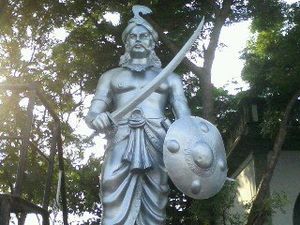

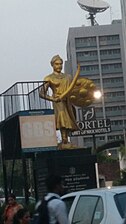
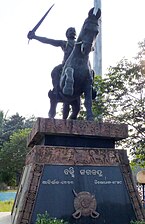
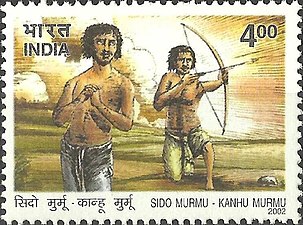
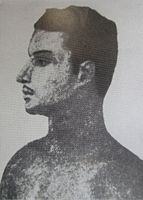


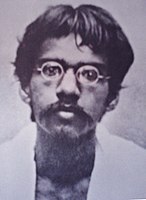
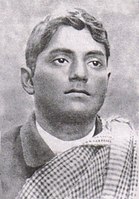


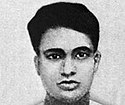
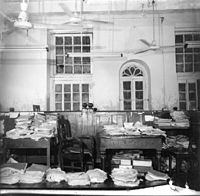



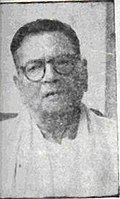


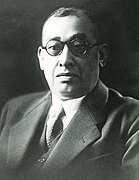







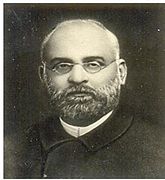
![Madan Lal Dhingra, while studying in England, assassinated William Hutt Curzon Wyllie,[117] a British official who was "old unrepentant foes of India who have fattened on the misery of the Indian peasant every [sic] since they began their career".[118]](https://upload.wikimedia.org/wikipedia/commons/thumb/e/e2/Dhingra.jpg/127px-Dhingra.jpg)
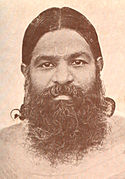
![Pandurang Mahadev Bapat, acquired the title of Senapati, meaning commander, as a consequence of his leadership during the Mulshi Satyagraha.[119]](https://upload.wikimedia.org/wikipedia/commons/thumb/c/c2/Statue_of_Senapati_Bapat_-_panoramio_%28cropped%29.jpg/143px-Statue_of_Senapati_Bapat_-_panoramio_%28cropped%29.jpg)
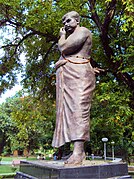
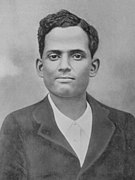


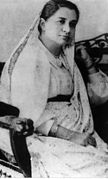
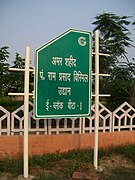

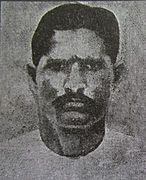
![Bhagwati Charan Vohra, died in Lahore[126] on 28 May 1930 while testing a bomb on the banks of the River Ravi.](https://upload.wikimedia.org/wikipedia/commons/thumb/9/90/Bhagwati_Charan_Vohra.jpg/140px-Bhagwati_Charan_Vohra.jpg)


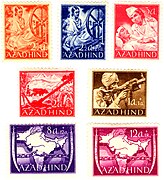
![Lal Bahadur Shastri, was sent to prison for one year, for offering individual Satyagraha support to the independence movement.[128]](https://upload.wikimedia.org/wikipedia/commons/thumb/4/45/Lal_Bahadur_Shastri_%28cropped%29.jpg/146px-Lal_Bahadur_Shastri_%28cropped%29.jpg)
